
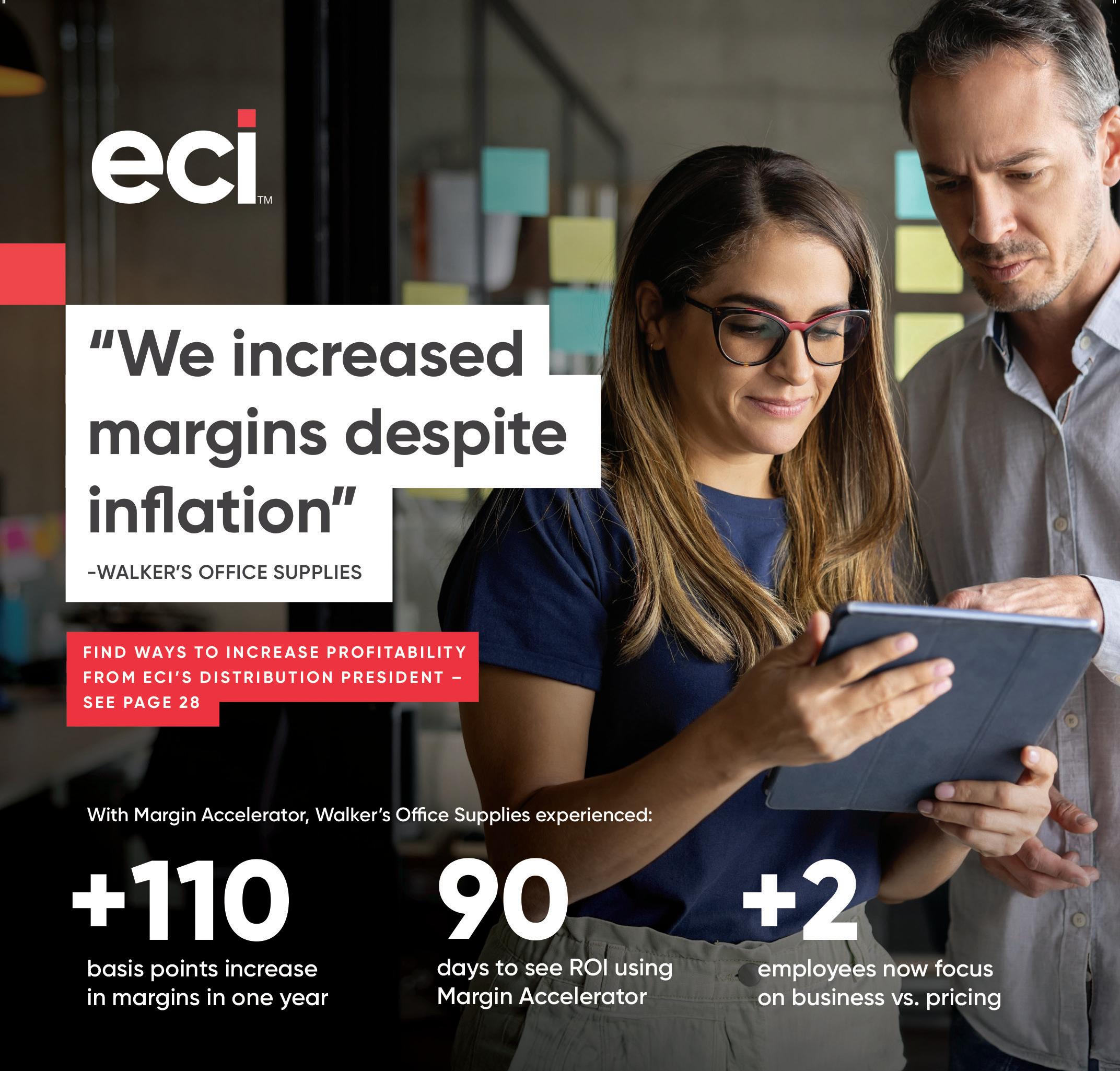
Connecting the business products world September 2023
INTERVIEW l Amazon dominates GSA platform l ODP’s Varis stuck in neutral l OT Group swoops for Nectere l New CEO at ACCO Brands l AI: friend or foe? l Print under pressure l NAOPA shortlist revealed INSIDE THIS ISSUE TECHNOLOGY SOLUTIONS Special Issue
Steve Schultz, RJ Schinner BIG
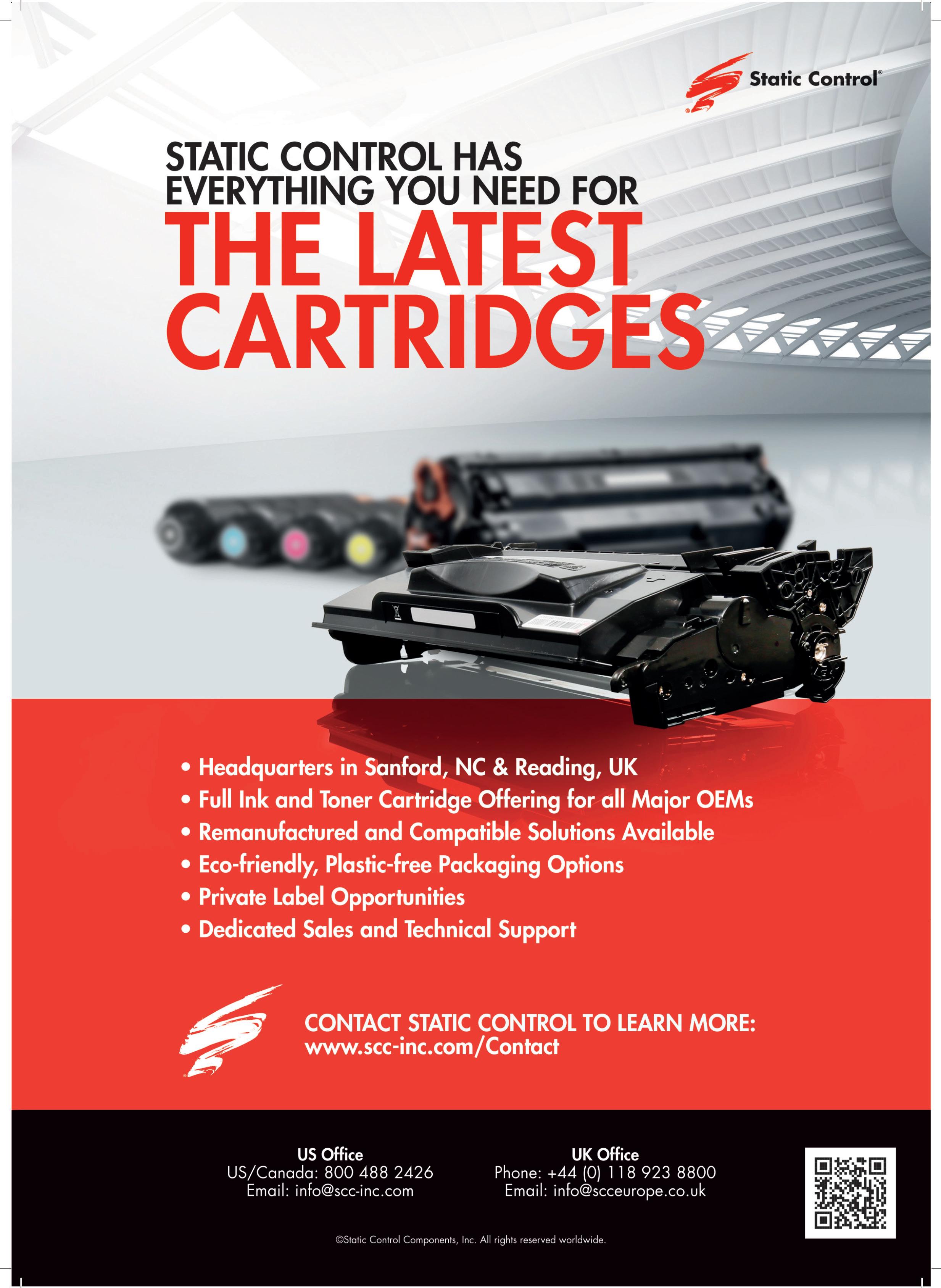
Big Interview: From the outside looking in
RJ Schinner, predominantly a redistributor of foodservice and jan/san products, has been on the periphery of the business supplies space for many years. Now, under the added guidance of new President Steve Schultz, the family firm aims to become a must-go-to destination for independent dealers. Schultz brings with him plenty of relevant experience. He worked for Essendant – then United Stationers – for 16 years, leading the wholesaler’s Lagasse and ORS Nasco businesses. This was followed by stints at GOJO Industries and S.P. Richards’ legacy jan/san and safety entities.
FEATURE: FULL VISION
Customer experience is the name of the game. If your clients are not having a good experience when shopping with you, they will look elsewhere.
People pay more to shop on big-box sites for a reason. Even a giant like Google factors in customer experience when positioning websites in its rankings.
The refinement and improvement of these optimisations is an enduring task for us, one that requires continuous investment, maintenance and innovation. For example, we have been working with each of our customers to get their sites updated from legacy methodologies to the latest and greatest.

18 Big Interview
Steve Schultz eyes up IDC as new President of RJ Schinner

24 Focus OT Group swoops for distressed Nectere
44 Category Update
Under pressure: imaging supplies, print and MPS
48 Advertorial Lamination in progress at ACCO Brands’ GBC
50 Preview: NAOPA
Shortlist revealed for the 13th North American Office Products Awards
58 Preview: Industry Week ’23 Getting together in the Big Easy
28 Interview
ECI’s Brian Bowerfind on technology in the IDC
30 Feature Software solutions and how they help dealers
36 Case Study
Egyptian Workspace Partners in Illinois, US
40 Spotlight AI: friend or foe?
42 Opinion Work in progress: data and content
REGULARS
September 2023 3
CONTENTS
Green Thinking News
OPI Small Talk
5
with...
Gerber
Word
5 Comment 6 News 14
16
60
minutes
Gert
62 Final
John Evans
TECHNOLOGY SOLUTIONS Special Issue TECHNOLOGY SOLUTIONS Special Issue Special Issue VENDOR SPECIAL Special Issue VENDOR SPECIA Special Issue VENDOR SPECIAL Special Issue TECHNOLOGY SOLUTIONS

The OPI team
EDITORIAL
Editor
Heike Dieckmann +44 1462 422 143 heike.dieckmann@opi.net
News Editor
Andy Braithwaite
+33 4 32 62 71 07 andy.braithwaite@opi.net
Assistant Editor
Kate Davies kate.davies@opi.net
Workplace360 Editor
Michelle Sturman michelle.sturman@opi.net
Freelance Contributor

David Holes david.holes@opi.net
SALES & MARKETING
Chief Commercial Officer
Chris Exner
+44 7973 186801 chris.exner@opi.net
Head of Media Sales
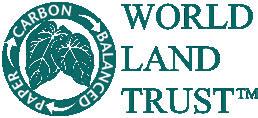
Chris Turness +44 7872 684746 chris.turness@opi.net
Digital Marketing Manager Aurora Enghis aurora.enghis@opi.net
EVENTS
Events Manager
Lisa Haywood events@opi.net
PRODUCTION & FINANCE
Head of Creative
Joel Mitchell joel.mitchell@opi.net
Finance & Operations
Kelly Hilleard kelly.hilleard@opi.net
PUBLISHERS
CEO
Steve Hilleard
+44 7799 891000 steve.hilleard@opi.net
Director
Janet Bell
+44 7771 658130 janet.bell@opi.net
Executive Assistant
Debbie Garrand
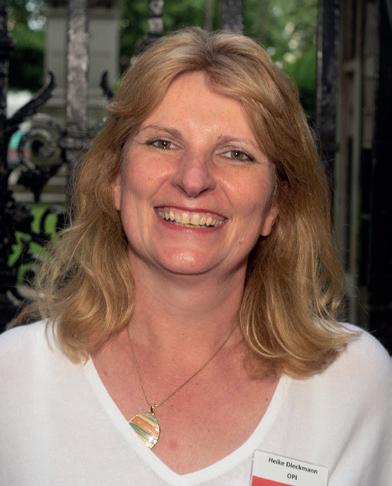
+44 20 3290 1511 debbie.garrand@opi.net
Follow us online

Twitter: @opinews Linkedin: opi.net/linkedin
Facebook: facebook.com/opimagazine
Podcasts: opi.net/podcast App: opi.net/app

Technology to the rescue
Last time in this column I spoke about growth and how everyone wants more of it. No surprise there. In this issue, we highlight a quite spectacular growth story – that of RJ Schinner, the $700 million US redistributor of foodservice and jan/san products.
A familiar face in our industry, mostly from his days at United Stationers, recently appointed President Steve Schultz talks of 20% CAGR over the past decade in our Big Interview (page 18) . To achieve this, mostly organically, is impressive. To maintain it – as Schultz and the Schinner family clearly intend to – will be even tougher. An operator of this size likely has fairly deep pockets to facilitate the inevitable costs which go hand in hand with scaling up.
Independent dealers – incidentally a channel Schinner is looking at closely – don’t have this luxury. But they still need to provide a top-rated service to their customers.
Technology is the backbone of that service and here is where our industry’s software solutions providers come in. From an engaging and user-friendly – as well as highly ranked – front-end webstore experience to all the back-end functionality which allows them to be comprehensive in their offering and competitive in their pricing, these providers are helping dealers navigate the choppy waters of e-commerce excellence.
A range of features is dedicated to the topic in this issue, including an interview (page 28), a case study (page 36) and several opinion pieces (pages 30, 42 and 62 respectively) – just follow the purple Technology Solutions sticker throughout the magazine.
In the context of technology, there’s no bigger subject right now than artificial intelligence (AI), which we take a good look at in our Spotlight (page 40). Is AI friend or foe; will it pave the way for a workplace revolution that eliminates, well, ‘work’?
I like the concept of what Harry Dochelli referred to at the recent Essendant virtual event (page 8) – cobots. Ignorantly, I had to look this up: a cobot, or collaborative robot, is a robot intended for direct human-robot interaction within a shared space, or where humans and robots are in close proximity. That sounds much better.
due principally to the fact that data cannot always be verified, it is possible that some errors or omissions may occur. Office Products International cannot accept responsibility for such errors or omissions. Office Products International accepts no responsibility for comments made by contributing authors or interviewees that may offend.

September 2023 5
No
COMMENT
The carrier sheet is printed on
Satimat
Silk paper, which is produced on pulpmanufactured wood obtained from recognised responsible forests and at an FSC® certified mill. It is polywrapped in recyclable plastic that will biodegrade within six months.
part of this magazine may be reproduced, copied, stored in an electronic retrieval system or transmitted save with written permission or in accordance with provision of the copyright designs and patents act of 1988. Stringent efforts have been made by Office Products International to ensure accuracy. However,
Office Products International Ltd (OPI) Focus7 House, Fairclough Hall, Halls Green, Hertfordshire SG4 7DP, UK Tel: +44 20 7841 2950 Connecting the business products world
OPI is printed in the UK by There’s no bigger subject right now than artificial intelligence [...] Is AI friend or foe? www.carbonbalancedpaper.com CBP0009242909111341 HEIKE DIECKMANN, EDITOR
Analysis: Amazon Business dominates GSA marketplace spend
Audit reveals the numbers for the US federal government’s online marketplace project
Amazon Business accounted for 96% of spend on the US General Services Administration’s (GSA) Commercial Platforms initiative in the federal government’s 2021 and 2022 fiscal years.
That was one of the figures revealed in a recently published report from the US Government Accountability Office (GAO), which is mandated by Congress to review the implementation of the programme.
Commercial Platforms has its origins in the 2018 National Defense Authorization Act, which directed the GSA to establish and implement a solution for federal agencies to buy everyday products through commercially available online platforms. In June 2020, three contractors were named for an initial three-year proof-of-concept phase: Amazon Business, Fisher Scientific and Overstock.
GAINING TRACTION
In the first 12 months of the contract to 30 September 2021, just $12.5 million of sales were made by the three suppliers. The latest GAO audit shows the initiative gained traction in the following fiscal year, with total spend increasing by more than 220% to $40.4 million.
Taking the first two years of the pilot phase together – approximately $53 million in sales – Amazon Business clearly dominated the programme, with around $51 million channelled through its marketplace. Over the same timeframe, Fisher picked up about $1.5 million and Overstock just $500,000.
According to GSA officials, Amazon’s high sales volume can be attributed to the familiar
user experience it offers customers and the fact many federal purchasers already had accounts with Amazon prior to the programme starting. The agency is therefore taking steps – informational sessions with buyers, for instance – to encourage increased spend on the other platforms. It has also shared feedback with platform providers to help them add new features that could better serve government customers.
The largest product category – by some margin – over the two years was IT broadcasting and telecommunications (including items such as computer displays, phone headsets and computer docking stations). This was followed by office equipment and supplies, furniture and furnishings, and domestic appliances and consumer electronics.
Federal agency participation grew in 2022, but by just a single-digit number. As of the end of September 2022, 27 agencies were making purchases on the programme, but three of them – the Departments of Agriculture, Veterans Affairs and Justice – accounted for 83% of the dollar volume.
FALLING SHORT
The GSA has established 11 metrics for evaluating the performance of the Commercial Platforms programme. One thorny area where targets are not being met is with the level of AbilityOne spend, despite it being a mandatory requirement.
In 2022, just 0.16% of sales went on AbilityOne products, well below the goal of 2%. This is being worked on currently. Indeed, it was the reason the solicitation for the next round of awards was delayed.
With the pilot phase due to come to an end on 30 September 2023, it was initially expected that contractors would be named well before then. However, with the request for proposals deadline having been pushed back twice, the GSA has extended the proof-of-concept period until the end of this year.
It has been a long and laborious process to get the Commercial Platforms programme to the verge of a full-blown series of awards. Furthermore, the current spending levels are just a drop in the ocean compared to the GSA’s estimated addressable market of $1-$2 billion.

6 www.opi.net NEWS
It has been a long and laborious process to get the Commercial Platforms programme to the verge of a full-blown series of awards
ACCO Brands makes CEO change
ACCO Brands has announced that CEO Boris Elisman is to retire, with COO Tom Tedford taking on the top job from 1 October. At that time, Elisman will continue as Executive Chairman until his retirement in the first half of 2024.

Tedford joined the manufacturer in 2010 as SVP of Corporate Marketing and Product Development. He then served as President of ACCO Brands Americas before becoming President of ACCO Brands North America. In 2021, he was named COO – an appointment that OPI suggested at the time could be part of a CEO transition plan. And so it has turned out to be.

Elisman commented: “During my tenure at ACCO Brands, the company and the industry have undergone significant changes and I am proud of our teams’ accomplishments during this period.”
Looking ahead, Tedford added: “I believe there are immense opportunities to enhance our leadership position in key categories, grow through share gains and new innovative product solutions, optimise our supply chain and improve our margin profile as we remain focused on delivering shareholder value and customer satisfaction.
“Near-term, we are committed to prioritising our free cash flow towards supporting our dividend and debt reduction.”
Varis roll-out stalls
The ODP Corporation’s (ODP) B2B marketplace platform Varis is taking longer to get off the ground than originally planned. ODP has made much of the potential of this new business segment, which is headed by former Amazon Business chief Prentis Wilson and counts several ex-Amazonians in its management team. The indirect procurement space it plays in is estimated at $4 trillion.
It had been hoped that purchases made through Varis would begin to have an impact on the top line in the first half of 2023. However, revenue in the second quarter was revealed as just $2 million – and this was generated by legacy customers using the BuyerQuest purchasing solution acquired in 2021.
ODP CEO Gerry Smith admitted that building Varis’ tech stack was taking longer than expected. He said issues were being resolved and the ramp-up of customers would only be put back by a couple of quarters.

Nevertheless, the delay in the roll-out has meant the reseller has upped its expected FY 2023 operating loss at Varis to a range of $60-$70 million.
Meanwhile, there was better news regarding ODP’s Federation strategy, which has seen it acquire around 15 regional dealers in the past few years. Federation partners now represent more than $500 million in annual revenue and CFO Anthony Scaglione said these businesses had continued to demonstrate “solid growth” in the second quarter.
“This market continues to be highly fragmented and our disciplined approach gives us a tremendous runway to keep growing our platform strategically over time,” he stated.
Responding to an analyst’s question, Scaglione said the Federation had been a “huge success”, with all partners doing “a fantastic job” of achieving cost-of-goods synergies and improving profitability.
ON THE MOVE
New Chair at EVO Group’s Complete EVO Group has named the head of its Premier Vanguard business –Dominic De Luca – as the new Chair of the Complete reseller business. He will also continue to lead Premier Vanguard.
CEO change at Shachihata
USA
Masaaki Okuno
is the new CEO at Shachihata USA. He has been at the vendor for more than 20 years. Most recently, Okuno was an Executive Officer at its Global Business division.
Leadership addition for Static Control exec Static Control has appointed Juan Carlos Bonell as its new CEO, effective immediately. He will also continue to serve as the Managing Director of the firm’s European operations.
New Office Power Commercial Director E-commerce and digital market specialist Helen Batstone has joined EO Group’s dealer technology and service platform Office Power as its Commercial Director.
IAI names VP
US manufacturer rep group Institutional Associates (IAI) has promoted Kevin Longshore to VP. In the role, he will provide a more hands-on service and explore opportunities in IAI’s traditional as well as emerging markets.
NEWS September 2023 7
Tom Tedford
Boris Elisman
Prentis Wilson
Analysis: Virtual reality
OPI reports on Essendant’s recent virtual conference and supplier event
million packages it delivers every day. It would have been impossible to absorb the remaining 80% across other carriers. Essendant’s recommendation to customers had been to order items early – hopefully dealers are not now sitting on too much stock.
Network optimisation was another area Engstrom spoke about. Recent investments have been made in the product information and transport management systems, while a pilot is being conducted on the use of cobots – collaborative robots for direct human-robot interaction – in one of the wholesaler’s facilities.
In July, US wholesaler Essendant held an online conference and trade show that was attended by hundreds of delegates and around 60 suppliers. Run on the vFairs platform, the event included – among other things – a Q&A session and town hall with three members of the senior leadership team: President/CEO Harry Dochelli; SVP of Sales and Merchandising Renee Starr; and SVP of Supply Chain Tim Engstrom.

It was the company’s first large-scale gathering since the ransomware attack which crippled operations for a period in March. This was a topic Elizabeth Castro, Essendant’s Director of Corporate Communications Strategy, quizzed Dochelli on during the Q&A.
“We are all vulnerable,” said the CEO, revealing the company was in “scramble mode” for 24-48 hours. He also reiterated that the wholesaler had done its due diligence prior to the incident, including holding several dry runs.
During the town hall, Dochelli said his team was “as confident as it could be” in its preparedness for another attack. While there are no assurances Essendant will not be targeted again, it would be unusual for cybercriminals to go after the wholesaler a second time, especially as no ransom was paid. Dochelli also believes the company’s data is “not that attractive” to bad actors.
UPS CONCERNS
Another topic high on the agenda was the threat of strike action by UPS workers – which was a real possibility in mid-July. Thankfully, as OPI went to press, it appeared the delivery giant and the Teamsters union had reached an agreement and industrial action could be avoided. Essendant is one of UPS’s largest customers, so there would clearly have been disruption in its supply chain.
As Engstrom noted, UPS would only have been able to handle around 20% of the 18
A major project has been the introduction of a third-party logistics (3PL) offering, which is something The ODP Corporation is also looking to develop with its Veyer subsidiary. As Dochelli noted: “As we look to diversify and strengthen our business, in order to support our customers long-term, we’ve got to find new ways to generate revenue and profitability. 3PL is a great spot for us and I’m excited about where this is going to take us in the next two to three years.”
EXPANDED ASSORTMENTS
Linked to supply chain capability is Essendant’s ability to expand its product assortments, a subject Starr spoke about.
“We’re really focused on gaining share and expanding into new customer channels for our key categories such as office products and technology, but we’re also looking at how to grow and expand our offering in jan/san, foodservice, safety and furniture,” she said.
According to Starr, Essendant is “uniquely positioned” to sell a broad range of items in all the above categories. This is thanks to several new vendor partnerships that have given access to, for example, 400 foodservice products and 2,200 new safety SKUs.
A new furniture programme called Alera Access Plus which uses distribution hubs in California and New Jersey has made a good start. Approximately 500 customers have already signed up, and Starr said the initiative was “generating a lot of orders”.
All in all, it was a well-attended and organised event – and unlikely to be the last such conference Essendant holds online. While some regional gatherings are still held in person, the wholesaler has fully embraced the shift to virtual. As Dochelli highlighted, it’s all about providing value and ROI.
NEWS 8 www.opi.net
Pictured, from left: Elizabeth Castro, Tim Engstrom, Renee Starr and Harry Dochelli
3PL is a great spot for us and I’m excited about where this is going to take us

Veritiv agrees takeover bid
US facilities and packaging distributor Veritiv has agreed to be taken private in a $2.3 billion deal. The company has entered into a definitive agreement to be acquired by an affiliate of investment firm Clayton, Dubilier & Rice for $170 a share, a premium of almost 20% over its closing price at the beginning of August.

The transaction has been approved by Veritiv’s board but still requires the green light from its shareholders.
ADVEO completes Top Office deal
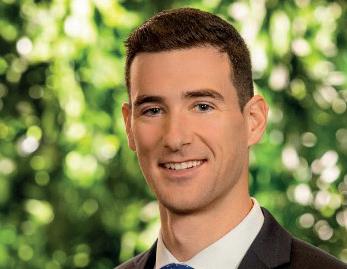
ADVEO France has confirmed the acquisition of office superstore retailer Top Office. The transaction was finalised in July, with ADVEO acquiring the brands Top Office and Top Office Business as well as the reseller’s websites.


ADVEO did not provide any further details, such as who now owns the 33 Top Office stores, of which just 11 were previously run under a franchise model. Top Office joins ADVEO’s three other go-to-market brands: Plein Ciel, Calipage and Buro+. It is a move which gives the multichannel operator both greater scale and more opportunity to develop in the retail space –a segment that has been faring relatively well in France.
Pilot creates subsidiary in India
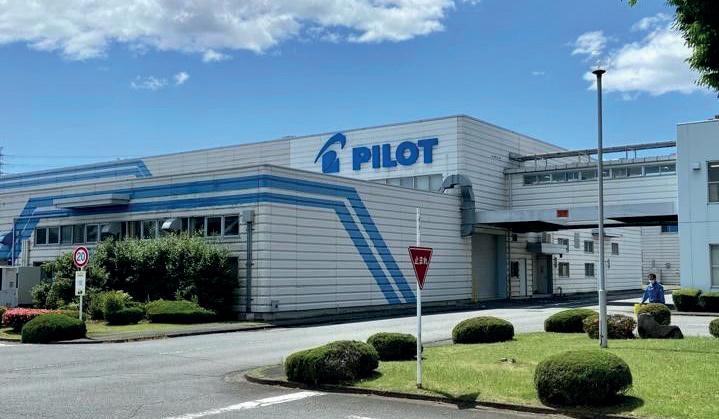
Promotions at SPR
S.P. Richards (SPR) has announced two senior promotions to its team. Charles McLaughlin has moved from his Marketing Communications Manager role to that of Senior Marketing Communications Manager. Meanwhile, Brian Moore has been promoted to Senior Category Marketing Manager. He will be responsible for developing innovative marketing approaches to all of SPR’s product categories.
Writing instruments leader Pilot is setting up its own manufacturing and distribution footprint in India. Pilot Pen India formally began operations as a single entity on 1 July 2023, effectively ending a distribution partnership the Japanese firm established with local vendor Luxor almost 40 years ago. Speaking to the Indian press, Pilot Corporation President Shu Itoh said having 100% control would allow the company to develop the brand more comprehensively. As well as setting up a local production unit, Pilot is looking to rapidly expand its distribution network over the next 18 months. Currently, Pilot’s annual sales in India are approximately $120 million. The goal is to triple this by 2028.
Eakes back on the acquisition trail
US dealer Eakes Office Solutions has made an acquisition in its home state of Nebraska.
The latest deal for Eakes involves Scottsbluff-based Western Plains Business Solutions, an established local source for custom printing, forms, signs and banners, and business paper products to customers in western Nebraska. Following the transaction, Eugene Batt, the owner of Western Plains for
the past 34 years and a 45-year print industry veteran, will retire.
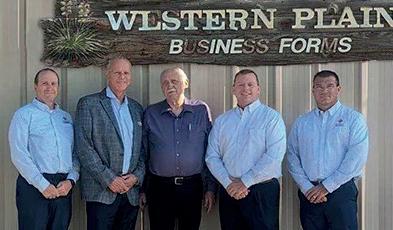
NEWS 10 www.opi.net
Charles McLaughlin
Brian Moore
Below, from left: Kevin Hafer, Mark Miller, Eugene Batt, Paul McKinney & Cameron Peister
Office Choice gives staffing update Essity continues restructuring in the US
Brad O’Brien, CEO of Office Choice, has provided OPI with an update on the organisation’s recent management and support team changes. Following the corporate restructuring of the Australian dealer group last November, O’Brien oversaw two key appointments in the first quarter of 2023. Brian Clutterbuck was brought in as CFO while Teresa Thompson was named Chief Marketing & Merchandise Officer.

In addition, O’Brien said there had been an opportunity to reshape the marketing and merchandising functions following the departure of National Marketing Manager Cameron Osborne in June. This has led to the appointments of Jasmine Maniquis, National Marketing & E-commerce Manager; Aaron Bassett, Pricing & Product Data Administrator; and Josh Turville, Digital Marketing Coordinator

An as-yet-unnamed Contractor –Special Projects has also been hired, with extensive experience in the technology category and in private label programmes.
Marcia Allan, named General Manager of Marketing last year, has left the group, OPI has learned.
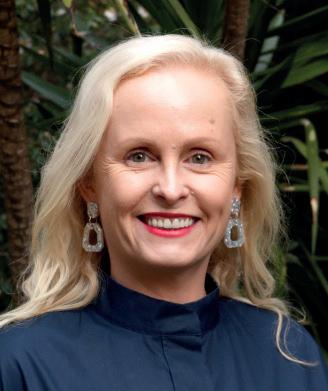
Tork brand owner Essity is to close two Professional Hygiene facilities in the US as it looks to focus on higher-margin business. The cleaning and hygiene vendor confirmed it is “planning to implement restructuring measures in Professional Hygiene in the US that include the closure of two production plants in New York state”.
The restructuring is expected to have a low single-digit negative impact on volume in the second half of 2023 and for the full year 2024. It is a similar rate to that seen in Europe in Q2 following Essity’s restructuring initiative there.
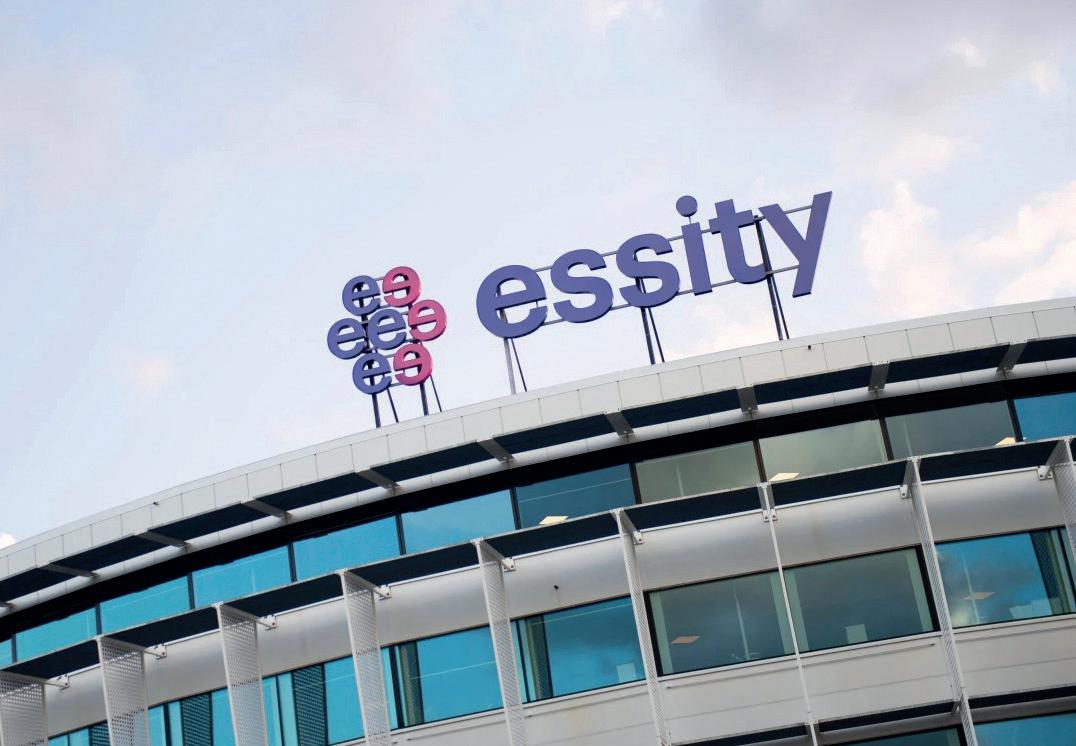
NEWS September 2023 11
Teresa Thompson
Brian Clutterbuck
BACK TO SCHOOL SPECIAL
Average cost of sending a child back to school in France
ODP makes big BTS donation

As part of its Start Proud! community investment programme, The ODP Corporation has donated 18,000 backpacks filled with $2 million worth of school supplies. In September, the reseller is running teacher ‘shopping sprees’ valued at $20,000 per school, supporting vendors including Boise Paper, Domtar and Crayola.
24% Secondary school parents in Ireland taking out a loan or borrowing from friends to meet BTS costs

Social media platforms key for BTS market
A growing trend for the global BTS segment is social media and influencer marketing. Skyquest Technology Group notes social media is being used to share product recommendations, reviews and for price comparisons. Meanwhile, brands are partnering with influencers to promote products on social media.







Post-it to win big 3M’s Post-it brand teamed up with actress, producer, entrepreneur and philanthropist Nicole Ari Parker, for its Think Loud sweepstakes campaign, giving parents the chance to win a $5,000 BTS shopping spree for their children – and another $5,000 for themselves.





























$94 billion










Predicted US back-to-college spending, about $20 billion more than last year

School supply drive for Staples CA
Staples Canada has launched its 18th annual school supply drive which has raised $16 million to date. From 7 August, in-store customers can add a donation to their purchase, which is allocated to one of Staples’ charitable partners. This year’s partners include Kiwanis Foundation of Canada and United Way Centraide.

NEWS 12 www.opi.net IN BRIEF
Philip Rist, EVP of Strategy, Prosper Insights & Analytics
PICTURE OF THE MONTH
Even though consumers plan to spend more on school- and college-related items this year, [...] they are stretching their dollars by comparing prices, considering offbrand or store-brand items, and are more likely to shop at discount stores
€262

EU adopts more reporting standards for companies
The European Commission has adopted the European Sustainability Reporting Standards (ESRS) for use by all companies, subject to the Corporate Sustainability Reporting Directive (CSRD).
The CSRD will take effect in the 2024 financial year. It requires all large companies in the EU – including subsidiaries of non-EU firms – and listed SMBs to publish regular updates on their environmental and social performance according to a common set of standards. In all, it is expected that around 50,000 organisations throughout the bloc will be affected.
Reporting requirements are governed by 12 ESRS that were proposed by the European Financial Reporting Advisory Group (EFRAG). The group’s final draft of November last year was subject to a number of modifications by the EU Commission before being adopted at the end of July 2023.
The changes include an extended phasing-in period for businesses with fewer than 750 employees, more flexibility for companies to decide which of the ESRS are material to them, and a reduction in the number of mandatory requirements.
Some environmental groups accused the EC of watering down EFRAG’s proposals, with WWF saying it had “caved in to pressure from conservative industry groups”.
T3L ups recycled content
European manufacturer T3L is using more recycled materials in the products of its Djois brand. Over the next few months, the company’s Smartfolder range is transitioning from virgin to 100% recycled cardboard which is FSC and Blue Angel certified.

At the same time, the Color Collection document protection and presentation line will begin using post-consumer recycled polypropylene (rPP). The new products are REACH compliant, made with at least 80% rPP, and are 100% recyclable.
Soennecken releases sustainability report
Soennecken has published its 2022 Sustainability Report, providing detailed insights into its comprehensive CSR projects. The German dealer group said it had been “committed to environmental protection, fair working conditions and the future viability of the cooperative and its members”. Highlights in the report include:

• the expansion of its own brand Oeco which currently comprises around 150 items;
• Soennecken joining Germany’s B.A.U.M., the now Europe-wide network for sustainable management practices;

• 40,272 parcels delivered in the city of Cologne by cargo bike, saving 5.5 tonnes of cardboard and 18.5 tonnes of CO2;
• 433 trees planted in partnership with PLANT-MY-TREE by the end of 2022 –another 1,350 will be added this year.
product sales grow at Grainger
Grainger’s High-Touch unit sold more than $1 billion worth of environmentally preferred products in 2022. In the company’s Q2 earnings call in July, CEO D.G. MacPherson said revenue from these types of items has increased over the past few years as customer conversations around their environmental footprint have become more commonplace. Grainger has also been working to lower its CO2 emissions. Since 2018, it has cut global absolute Scope 1 and Scope 2 emissions by 26%. These results mean it’s nearing its 2030 goal of a 30% reduction.

14 www.opi.net GREEN THINKING
‘Green’
OfficeMax NZ introduces expansive CSR initiatives
More sustainability support needed from print vendors
Print research organisation Quocirca says vendors need to provide better support to enable channel partners to fully capitalise on sustainability-led sales opportunities.
In its 2023 Channel Sustainability Study, Quocirca estimates that an average of 12% of channel revenue is derived from sustainability-led sales, but this is expected to rise to 22% by 2025.
OfficeMax New Zealand has launched a Responsible Supplier Code and Sustainable Packaging Guidelines for approximately 500 domestic and international suppliers.

They are designed to support OfficeMax’s 2020-2025 Sustainability Strategy and improve the social and environmental footprint of its supply chain. The launch follows a trial and feedback period with suppliers.
The Responsible Supplier Code will focus on enhancing ethical business activities. Vendors will need to self-assess their organisations against Standard, Standard PLUS or Advanced criteria in the coming year. The Standard level is the minimum required to continue doing business with OfficeMax. Suppliers have to understand what they have to do prior to the commencement of an audit programme which will launch in July 2024.
The Sustainable Packaging Guidelines were developed to align with the Plastic and Related Products Regulations 2022. They will see all suppliers within OfficeMax’s supply chain support a circular waste process by maximising the ongoing sustainable value of packaging materials. This, in turn, will support OfficeMax in reaching its goal of achieving 100% reusable, recyclable or compostable packaging by 2025.
Pukka Pads adds solar energy
Pukka Pads has finished the installation of its first solar panels at its distribution centre in Lutterworth, UK.
Described as a “huge milestone”, the vendor said its solar energy initiatives are part of an effort to become carbon neutral and reduce dependency on the national grid. The new panels – which Pukka Pads claims will reduce CO2 emissions by around eight tons a year – will be used to power its fleet of forklift trucks at the site as well as an electric car charging station.
Around four in ten companies say sustainability criteria feature in some or all of the RFPs they respond to, with 92% stating customers are prepared to pay more for solutions with a stronger sustainability focus, at least some of the time.
The key areas of interest are energy-efficient hardware (65% of respondents), followed by long-life consumables and toner (35%) and minimum end-of-life waste (30%). These priorities are reflected in the topics channel partners most want more support on, namely:
• clear and detailed metrics on product life cycle impact (38%);
• help in identifying ways to advise customers on saving energy across a print fleet (36%);
• carbon footprint assessment tools (35%).
Only 20% of respondents say they are fully satisfied with the support they are receiving from vendors on sustainability. “Businesses are looking to acquire print technology that is efficient, secure and sustainable throughout its entire life cycle,” said Quocirca Director Louella Fernandes.
Brother awarded ecolabel
Brother UK has received the Blue Angel certification for its recycled toner cartridge, the TN-3512 RE, produced at Brother’s facility in Slovakia. The vendor received its first Blue Angel in 2001 for a laser printer and has been working to acquire the certification for more products ever since.
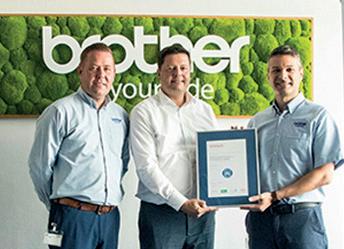
As part of its environmental efforts, the OEM also collects used cartridges from laser printers and all-in-ones, recycles them into toner cartridges, and redistributes them.
As of March 2023, around 37 million cartridges had been recycled across the group, says Brother.
GREEN THINKING NEWS September 2023 15
The heat IS ON
As the US state of Arizona sweltered in temperatures exceeding 110°F (43°C), OPI Talk spoke to Ian Wist, General Manager of Wist Business Products and Equipment, headquartered near Phoenix


The July heatwave
Ian Wist: We are used to days when it gets up to 46°C, but what’s unusual this year is that we had almost 30 straight days of it. However, it has had less impact on business than you may think. If there’s a city that’s adjusted and ready for extreme temperatures, it’s Phoenix.
At Wist, we have taken a closer look at our drivers and their well-being to make sure they’re not overheated and are drinking enough fluids. For example, we have added extra fans to their trucks so they have more air circulating through the cab. For us, it’s about the health and welfare of our people who are outside, because it’s tough for them.
On the product side, we have been shifting a lot of water. We are selling the equivalent of a 40-ft shipping container every other day –tens of thousands of cases. If you had told me last summer we’d be doing this in 12 months’ time, I would have said “probably not”.
To me, it just demonstrates that, to remain successful, you have to pivot every day to provide what customers want. We’re moving into so many different adjacencies, but it is a natural evolution and we have to embrace it.
Buying local
We are an active member of Local First Arizona, which is celebrating its 20th anniversary in 2023. We have a partnership agreement whereby the agency facilitates introductions for us to organisations and businesses in the state. Local First gets a small percentage of profit on those sales, which helps in keeping its lights on. It benefits both of us by making sure businesses here remain healthy.
The buy local trend is gaining a little more traction every year. What COVID did was increase customers’ awareness of all the categories a business products dealer can
Ian Wist
bring to the workplace. It started with PPE –masks and gloves, etc – and local companies now see us as a partner for many more products. The water I’ve just referred to earlier is an example of this.
Greater emphasis on sustainable products
Large organisations have had ‘green’ committees for some time, but we are finding they’re finally beginning to have an impact on purchasing decisions. In the past, they would make recommendations, but the products would either be too expensive or the procurement department would prefer a different item.
Now, we’re seeing these committees gain more influence. Some spending is being diverted to higher-priced, sustainable products because there is a belief this will make a difference [to the planet].
From our point of view, we do whatever we can to keep our carbon footprint as small as possible. This includes regulating office temperatures during the day and night, and being very methodical with truck routing so we are not wasting fuel.
Independent Suppliers Group update Mike Gentile is retiring and a very important decision has to be made about the new leadership. There are four people on the committee leading the search process and working hard to get to the right individuals. When a candidate has been selected, he or she then has to be approved by the board. It does take time, but we are hopeful we can get it done in time for Industry Week in October.
16 www.opi.net SMALL TALK
The buy local trend is gaining a little more traction every year

LOOKING IN the outsideFROM
RJ Schinner has been on the periphery of the business supplies space for many years. Now, under the added guidance of industry veteran Steve Schultz, its aim is to become a must-go-to destination
The name Steve Schultz is perhaps more familiar to many readers of OPI than the company he now works for: RJ Schinner.
After flying under the radar somewhat over the past few years, Schultz made headlines in recent months, first with his appointment in April to the role of President of Schinner and then, in June, when he was named Chair of City of Hope’s National Business Products Industry (NBPI) Council.

Highly respected, pragmatic and extremely knowledgeable in his field, he talks to OPI’s Steve Hilleard about what RJ Schinner, chiefly a redistributor of foodservice and jan/san products, brings to the business products industry – and the independent dealer channel (IDC) within it.
OPI: Let’s start with a run-through of your career to explain your background.
Steve Schultz: Sure. I’ve worked in a variety of redistribution and manufacturing organisations over the past 30 years. The most formative have been my 16 years at United Stationers – now Essendant – where I worked on growing the wholesaler’s Lagasse and ORS Nasco businesses.
I left in 2012 and joined GOJO Industries, which was a fantastic experience in a family, privately-owned organisation. After approximately six years there, I joined the other large wholesaler in the business supplies space – S.P. Richards (SPR).
About 20 months later, I had a front-row seat at the table when Mike Maggio and Yancey Jones Sr bought the OP wholesale side of
SPR – that was in 2020, in the early days of the pandemic. At the time, there was also a portfolio of jan/san and safety companies that SPR had bought over the years as part of its diversification strategy – Garland C Norris, The Safety Zone and Impact Products, for instance. When Genuine Parts decided to divest these businesses, we packaged them up and formed a company called Supply Source with private equity backing. I ran that new standalone organisation for two and a half years. Then it was time to move on – to RJ Schinner as it happened, where I’ve been since April.
OPI: What’s the story behind this new job?
SS: I didn’t necessarily target RJ Schinner, but I’ve known the family for about 25 years. When they reached out to check what my aspirations were post Supply Source, we spent a lot of time talking about my experiences and my ability to bring an outside, professional point of view to their rapidly growing business. It was a great opportunity for mutual value creation – that’s how I would describe it.
Wholesale redistribution is in my blood apparently – I don’t seem to be able to get away from it.
18 www.opi.net BIG INTERVIEW
OPI: Quite often in family-held businesses, there’s a hesitancy to hire someone from the ‘outside’. But this has clearly happened here. Is this a succession issue, a change in strategy or just coincidence? I guess you’re almost part of the family if you’ve known them that long.
SS: Well, I haven’t been invited to join in family holiday traditions, but our shared history certainly helped. My track record both as a supplier and competitor to Schinner created some unique circumstances of familiarity. But I would actually say that Schinner has been bucking the typical trend you’re referring to – it has routinely reached out in the past and brought in outside expertise.
Ken Schinner, our CEO, is the third generation of family leadership. I suspect in the next three to five years we’ll see the fourth

generation coming in. I felt very comfortable joining the organisation. I’ve worked for public companies, private family-owned firms and private equity-backed entities. I’m not saying one ownership model is better than the other, but having been given the chance to take a leadership position again, in a family-owned business, it was something I jumped at.
OPI: What’s your remit?
SS: It’s threefold: my job is to help develop growth strategies for the company; to reinforce foundational operating practices that you naturally have to scale to support growth; and, finally, to retain and strengthen the family and growth-orientated company culture Jim and Ken Schinner have worked so hard to build.
In short, I would say that I add experience and bandwidth to RJ Schinner’s already strong leadership team.
OPI: Can you give a brief overview and highlight some company milestones?
SS: Of course. RJ Schinner has been in business for 65 years. It was founded and is still headquartered in Wisconsin and is one of the largest privately-held redistribution
BIG INTERVIEW Steve Schultz September 2023 19
I add experience and bandwidth to RJ Schinner’s already strong leadership team
companies in the US with annual revenue eclipsing $700 million this year. What is really exciting is the growth we’ve experienced pre-pandemic but also during COVID-19.
Schinner has enjoyed a ten-year CAGR north of 20%, essentially doubling the business every four to five years. I would call that an excellent run.
Geographic expansion has been a huge part of this growth – the company has evolved from a regional player to a true national redistributor over the past decade. We have just opened our 20th facility in Southern California, broken ground on a new facility in Minnesota and are actively moving or expanding four of our distribution centres across the country. Reinvestment is a big part of the family business model and strategy.
In terms of staff, we employ over 600 people. About 35% of those employees are customer facing – they are working in sales, marketing, customer service, logistics, etc. It’s a real differentiator.
We have 150 tractors and trailers with our own driver employees and deliver more than 90% of our revenue nationally with our fleet. It means we have the ability to completely control the service model which is a crucial part of Schinner’s go-to-market strategy. It’s a bit different to some of the other wholesale operators in the US and our comprehensive
national reach with our fleet of trucks is definitely another big tick.
Something else to mention is our product scope and its evolution. RJ Schinner has its roots in foodservice disposables, but today the business is 50% foodservice and 50% janitorial and paper. This change is noteworthy as regards the ability to leverage our mix to really unlock additional growth in the years ahead.
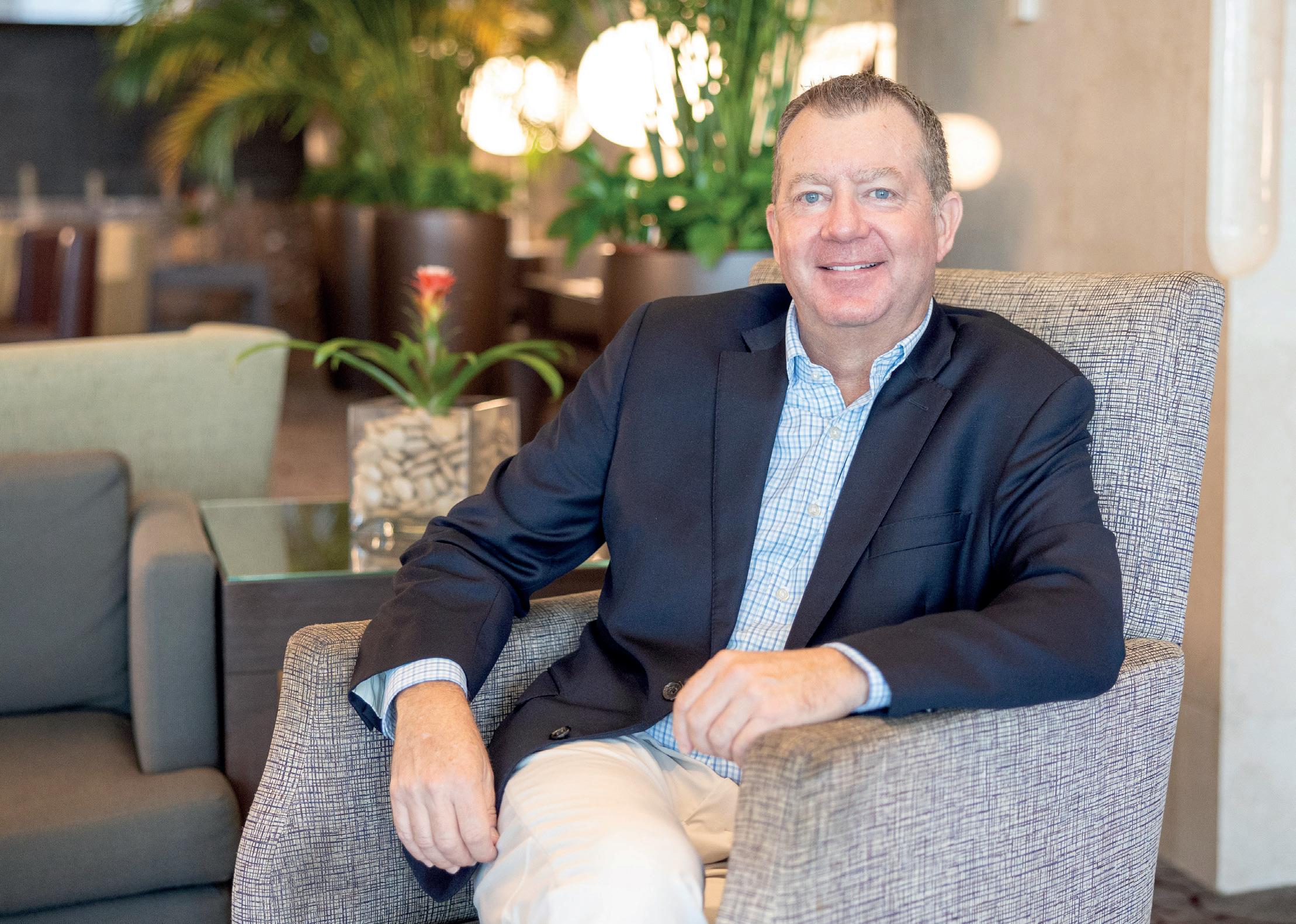
OPI: To what extent has the considerable M&A-driven growth of companies such as Bunzl helped determine your strategy?
SS: Schinner has done a few small tuck-in acquisitions of some single location independent redistributors in the US over the past decade – nothing on a broad scale. This is why we’re one of the industry’s darling growth stories from an organic growth perspective. When I worked at other wholesalers, the use of M&A was a real driver to differentiate and diversify away from core OP. Schinner hasn’t had to acquire to spread its reach.
That’s not to say we’re not in a position or don’t have the ability to use strategic acquisitions as a growth driver. But we still have a full plate, if you will, for unlocking amazing organic opportunities.
OPI: You use the term ‘redistribution’ which is not that widely known to my knowledge.
BIG INTERVIEW Steve Schultz 20 www.opi.net
Can you define it? What, for example, is the difference – if any – between redistribution and wholesale distribution?
SS: I think it’s a purist definition. Pure wholesale means you do not serve the end consumer and are 100% dedicated to selling to distributors, resellers, dealer communities, etc, in the various channels. But sometimes we conflate wholesale with redistribution, with redistribution having a bifurcated strategy whereby redistributors also serve certain channels directly.
RJ Schinner is pure wholesale but, to confuse things even further, we actually do call ourselves a redistributor. However, we do not sell to the end consumer and are focused on the reseller communities. Make sense?
OPI: (laughs) Clear as mud. Let’s talk about the team at Schinner. You mentioned Ken as the CEO and you’re the President.
SS: Yes. It starts with Jim Schinner, Chairman and our patriarch. Jim is second generation and, as I previously mentioned, Ken the third. Deservedly, Ken moved to the CEO role to vacate the role of President which he occupied for many years before my arrival.
The senior leadership team of Jim, Ken and I is paired with a seasoned selection of individuals in their various functions. Some have been with the company for a long time; this is blended with new recruits who bring considerable outside experience to the table.
The third leg of the stool is imported items which, I think, are vital for bringing the appropriate wholesale value proposition to multiple channels of distribution. The pandemic really accelerated the role of imports when it was a case of where could you find product – in our case predominantly Southeast Asia.
For Schinner – and again, I credit Jim and Ken – importing has been an essential ingredient in our growth. Five years ago, so pre-pandemic, Schinner established a WFOE – our wholly foreign-owned enterprise in Shanghai. Six company employees now manage a rapidly growing import business which adds quite a bit of depth and dimension to our overall product and service offering.
OPI: What impact did the pandemic have on the company; have there been any transformative effects?
SS: I was with another wholesaler when it all started, so any comments about how RJ Schinner has fared are post-pandemic learnings. I think of COVID-19, from a business perspective, as comprising three phases, nuanced by business type and product mix.
Generally, most of us experienced extreme growth and a colossal surge in demand in the early months – March 2020 through to September/October in the US, I would say.
This was followed by phase two – rapid decline. It was the effect of consumers being sheltered at home and wildly shifting demand patterns. Production caught up with demand and ultimately overstuffed the pipeline. This period lasted another six months to a year, depending on your positioning in the industry.
I give Jim and Ken a lot of credit for breaking the mould, so to speak, from the provincial-type thinking we so often see in family-owned organisations to really opening that aperture and thinking more broadly about the future growth and needs of the company.
OPI: Let’s talk about product. I guess a lot of Schinner’s sales come from brands and products our audience will be familiar with.
SS: For sure. The national brands make up the broad offering of foodservice, paper and janitorial products you would expect to see in any wholesaler and definitely at Schinner.
Equally as important are own brands. Our private label offering is very robust across the foodservice and paper categories in particular, but there are also some janitorial products.

The third phase is the most important: the aftershocks. As a global health issue, the pandemic has been declared over, but the aftershocks are still with us: shifting demand and consumption patterns; the market’s – and end users’ – acceptance of item substitution; dealing with excess inventory.
I think great companies – and I put RJ Schinner in this category given what I’m able to see now – were positioned well going into this hugely disruptive period and came out stronger on the other end.
I would argue the business navigated all the ups and downs very well and is now positioned to continue with its track record of growth.
OPI: 20% CAGR is certainly not easy to maintain. Did that faze you when you were considering taking on this role?
SS: I recall joking with Jim and Ken that my arrival would likely coincide with our CAGR going down. When you get to a certain level, the law of big numbers starts to kick in.
BIG INTERVIEW Steve Schultz September 2023 21
Great companies [...] were positioned well going into this hugely disruptive period and came out stronger on the other end
Everyone at Schinner should be very proud of the milestone of achieving a decade of 20% CAGR, and the company remains in the mindset of continuing to create double-digit growth and to stay on pace. Breaking the $1 billion barrier would be a fantastic achievement for a start.

There’s no question in my mind that market opportunities exist to continue growth at accelerated levels. Externally, we will always encounter macroeconomic difficulties and competitive challenges. Internally, meanwhile, rapid acceleration puts extreme pressure on all functions of a business.
Growth can cover a multitude of sins. But at the same time, organisations with these phenomenal trajectories need to look at the supporting cast – the infrastructure required to sustain and continue to build out support for those numbers. This is where businesses sometimes fall down.
Part of my responsibility is to do exactly that – make sure we’re looking at the overall scale of the company and have the competencies and capabilities to continue to be able to support the capture of the opportunities which appear available.
OPI: Can you give a flavour of your customer base in terms of the different segments and the relative importance of independents versus other clients?
SS: The core of the current RJ Schinner business is in the foodservice, paper, packaging and janitorial distribution community. We have a growing industrial and healthcare distribution base as well as a meaningful foundational position in the office products IDC.
We have very little exposure to the big box players in the US. It’s not an overt strategy to stay away, but more a reflection of where we believe the overall value proposition of Schinner is most effectively deployed. And it’s in the IDC where we see the biggest potential.
OPI: You have a relationship with Independent Suppliers Group, is that right?
SS: Correct. We have established and growing relationships with most, if not all, of the buying groups and marketing organisations OPI readers would be most familiar with.
OPI: You use the phrase ‘foundational position’ in the IDC. What are your goals?
SS: Yes, it’s definitely still foundational and predominantly through working with some of
BIG INTERVIEW Steve Schultz 22 www.opi.net
There is always a time when an industry is ripe for consolidation
For more from the interview, including topics such as channel blurring, data content and e-commerce capabilities, and the impact of hybrid working on the jan/san space, see our Xtra content in the September issue on opi.net
the group affiliations just mentioned. There’s an important distinction between Schinner and some of the other wholesale alternatives.
We don’t aspire to have ‘wrap and label’ or small parcel national drop-ship capabilities, for instance, so servicing a stockless e-commerce dealer set-up is not part of our strategy. That’s by design. It isn’t that we can’t or wouldn’t, but it’s not the sweet spot.
It begs the question of where we can add value. For the best part of the last decade, dealers have migrated away from facility maintenance and breakroom as merely a convenience category and begun to position themselves as real destinations for full-line foodservice and janitorial products. This is where we are strong.
As I mentioned, we control the service proposition with our fleet. So, as the IDC continues to evolve and become more committed in these categories – and the leading players are already a destination for these products for their customers – we become a viable option and alternative, supplementing, filling gaps, providing depth and breadth, and offering advantaged services and pricing. It’s ultimately how we see our dealer strategy evolving.
OPI: Consolidation and M&A remains a hot topic – we spoke about it briefly already. You’ve seen plenty of it in the early part of your OP career, but now there’s a lot of it coming from your space too. I’m talking about companies like Imperial Dade, BradyIFS, etc. What’s your view?
SS: It’s fascinating. Earlier in my career, as you say, we were the acquirer, completing four acquisitions while I was at United. There were so many roll-ups in the OP world and then the buying into all the adjacencies in the jan/san and industrial space.
Now we’re seeing similar consolidation patterns in the jan/san world led by Imperial Dade, Brady as well as Envoy Solutions with FEMSA. There’s always a time when an industry is ripe for consolidation – it was true for OP in the early 2000s and now is that time for the jan/san sector.
Does it have an impact? Of course, and you always need to consider your own position strategically and transactionally with those consolidators. However, even with consolidation, about 50% of the US marketplace is still in the hands of independent, single entity resellers. And these operators are growing and taking share by offering a differentiated service, white glove treatment, specific local product knowledge and an awful lot of know-how.
OPI: It sounds as if you’re positive about the future. What bold predictions would you make as to how the industry might look over the course of the next few years?
SS: I don’t know about bold, but I see consolidation continuing over the next three to five years. The pace may slow, but I’m convinced it will remain a market driver.
From a Schinner point of view, we have the luxury of operating in two areas of opportunity. Wonderful macro changes are happening in the foodservice space with the influence of sustainability, global manufacturing and the higher propensity for takeaway and carry-outs. Some of it is mainly shifting products, but there are also new trends that will shape the foodservice disposables side of the equation.
Janitorial and paper, meanwhile, typically runs around US GDP over time. And while the outlook for the next couple of years may be low single digits as we continue to deal with post-pandemic return-to-work issues, many of our suppliers and customers are positioned to outgrow the overall market through a myriad of different growth drivers.
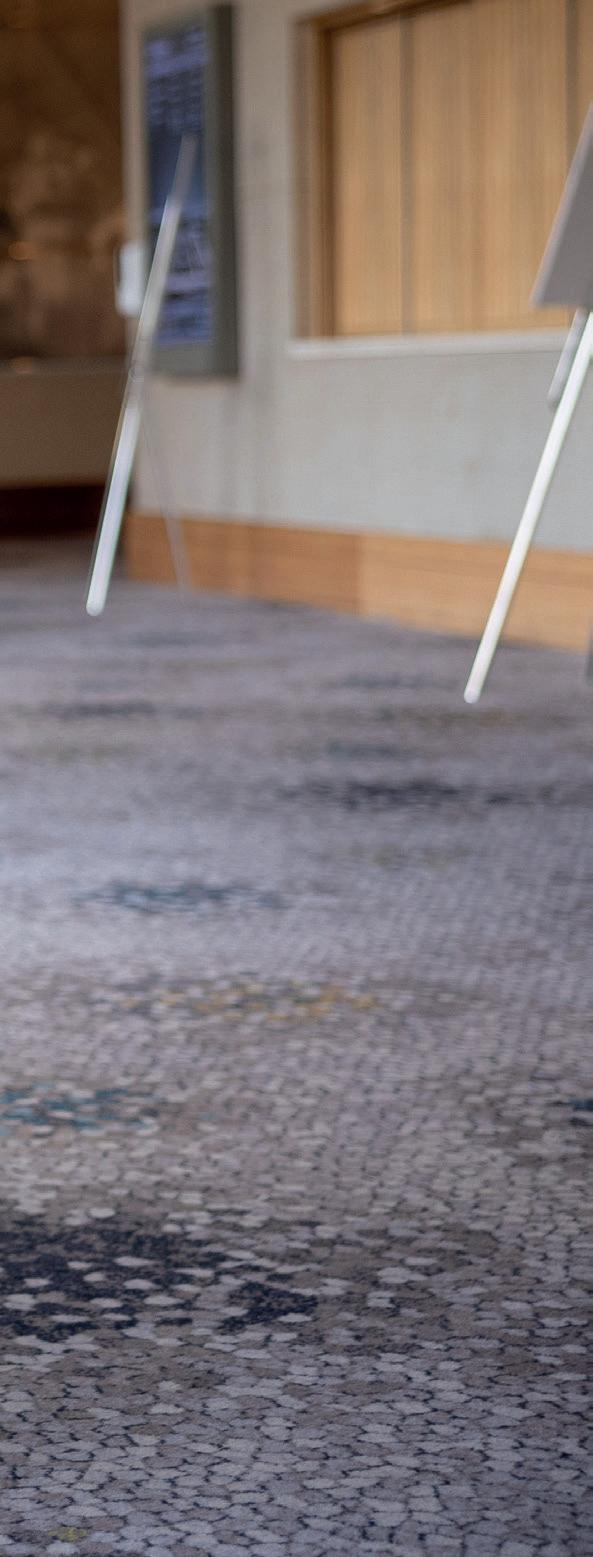
These are the partners we want to align with and continue to invest in – and the ones we’ll grow with. So yes, I am positive about the overall outlook for our industry.
OPI: One final question and this one is completely unrelated to what we’ve talked about so far. You’ve fairly recently taken over chairing the NBPI Council at the City of Hope. What should we expect from your chairmanship tenure?
SS: First of all, I want to say what an absolute honour it is to be involved with City of Hope at any level. I thought the pinnacle of my connection was serving as the Spirit of Life honouree in 2017.
So, when I was approached with the opportunity to throw my name in the hat for Chair, I was humbled to even be considered. Filling the big shoes that Scott Light leaves is going to be a tall order. Scott became Chair after a long legacy of seven others who were icons in the OP industry. He, as somewhat of an outsider to the traditional OP space, was the Chair who epitomised the shift from the National Office Products Industry to the National Business Products Industry Council.
From this standpoint, I look at my tenure as a continuation of the evolution of our industry’s support for City of Hope: the janitorial, industrial and certainly the OP communities coming together, outside of day-to-day business, in pursuit of being able to meaningfully contribute to the great work that City of Hope does. That’s something I know we can all get behind.
BIG INTERVIEW Steve Schultz September 2023 23
OT GROUP steps in
Just a few months after its Spicers wholesaling business reported a “five-year multimillion pound” agreement with Nectere, OT Group made a “strategic investment” in the UK dealer services organisation.
Several weeks after the announcement and at the time of OPI going to press, OT Group still hadn’t disclosed the exact nature or the amount of the investment, but the deal apparently is not being viewed as an acquisition per se.
Nevertheless, with a press release referring to the “inclusion of Nectere into the OT Group” and Nectere pointing to “a significant cash injection and the successful securing of funds”, it can probably be assumed that OT exercises a strong degree of control.
Both parties are also keeping quiet about the exact reasons for OT Group’s intervention and what the consequences would have been had it not done so. There is, perhaps, a clue in a letter Nectere sent to its stakeholders.
“We recognise that market conditions have affected most, if not all, companies in our sector and [we haven’t] been immune to this,” it wrote, adding: “The past few months have without doubt been impacted by [the] credit squeeze and confidence in our company.”
BUSINESS IN MOTION
It has been an ‘interesting’ few months for Nectere, to say the least. In February, founder Paul Musgrove and his wife Serena – joint owners – sold the firm in an MBO led by Mike O’Reilly and Heema Naik. At the time, it was said the transaction had been “carefully structured to secure the future of the business”.
Shortly afterwards, a long-standing wholesaling agreement with EVO Group’s

VOW suddenly came to an end and Nectere moved over to Spicers. Whether that was related to the leadership change at EVO last December, the fall-out of the failure of leading independent reseller Complete and its acquisition by EVO in January or other factors is not clear. Nectere’s Head of Commercial Steve Harrop underlined the better commercial terms achieved with Spicers following a period of “skyrocketing” costs.
Then, just weeks into the Nectere/ Spicers relationship, came news of OT Group’s investment to shore up the dealer organisation’s finances. It appears that OT Group’s hand was forced into injecting capital into Nectere – a move that is possibly not dissimilar to the situation which resulted in its main direct competitor acquiring Complete at the start of the year.
HISTORY LESSON
Martin Eames, the recently retired former owner of Product Promotion Services, adds a historical perspective. “I understand Spicers has been struggling to make significant headway in the dealer channel due to a range of issues, particularly with a problematic systems investment,” he notes.
“Therefore, it is worth remembering the early days of Spicers in France [in the 1990s]. The business initially failed to make much impact until it invested in two dealer groups, first creating Calipage, then acquiring Plein Ciel.
24 www.opi.net
FOCUS
There has been further market consolidation in the UK as OT Group takes a stake in Nectere
–
by Andy Braithwaite
The past few months have without doubt been impacted by [the] credit squeeze and confidence in our company

“These transformed Spicers France’s performance, so perhaps the Nectere investment is a similar move.”
An industry source who wishes to remain anonymous says tying in Nectere’s wholesaling spend to Spicers – which OPI estimates at approximately £10 million ($12.7 million) – is a “logical” step.
“It’s no secret that Paragon [OT Group’s owner, which recently rebranded to Grenadier Holdings] wants to double revenue over three years. It has to get that from somewhere and, as the number of dealers in the market continues to decline, competitors are fighting over a smaller pie.”
Nectere has been diversifying out of core stationery and office supplies, today accounting for just over 35% of revenue. This ties in with OT Group’s goal of offering a million products by the end of 2023 and three million two years later via its SmartPad platform. Nectere partners will also have access to a growing range of services which can be repackaged for them.
“An exciting aspect of the Nectere model is that all partners are on the same platform,” adds Harrop. “It means you can really push out the marketing collateral and content, particularly working with suppliers and the wholesale channel. I believe, with the stable support of OT Group, the potential is huge.”
He adds: “I view this as a land grab for dealers. It doesn’t necessarily mean OT Group will go out and buy other dealer groups, but I can see it building out as many services as it can within Nectere and then using this to recruit other dealers.”
OT Group’s growth ambitions probably suffered a blow when Complete ended up in the EVO camp. That would have added more than £100 million to its top line. Now, with Nectere aligned, it has about 130 reseller partners that give Spicers a strong footing at the smaller end of the market.

LOOKING AHEAD
Industry veteran Harrop has been acting as the public face of Nectere over the past few months and is keen to look forward.
“It’s very clear we have a unique entrepreneurial model, and the way we go to market will be protected by being with OT Group,” he says, pointing to the opportunity for both financial and operational synergies between the companies.
The platform part is critical for Nectere. It is currently running on a legacy system which is coming to the end of its life. While OT Group has had some teething troubles getting up to full speed after its own ERP implementation towards the end of last year, its scale and up-to-date e-commerce architecture is another obvious area where it can come to Nectere’s rescue.
Says Harrop: “From our perspective, we need the service provider to give us a platform and let the dealers go out and sell. There is still room in the market for smaller independent resellers, but unless we are careful, our industry is going to end up with a handful of large players.
“Our partners have a massive instinct to survive, but they have to have the support behind them, and this is where we sit – now with the backing of OT.”
He concludes: “The industry wants an exciting alternative, and suppliers want to see their customers succeed. That’s the message I’m getting. Of course, we now have to go out and deliver.”
TOO MUCH PRESSURE
Nectere has typically been viewed as something of a success story over the past 15 years, starting from scratch and developing into a £37 million business by 2018. Since then, however, its top line has been eroded by almost £10 million, according to its most recently available public accounts.
Despite a focus on reducing costs and taking steps to safeguard cash flow, it appears the inflationary environment and sluggish economy coming out of COVID was too much of a burden for the new management structure.
OT Group has had its own issues recently as well, but has an ambitious owner with deep pockets. It may have missed out on Complete, but Nectere might give Spicers just the sort of impetus it needs.
FOCUS OT Group/Nectere 26 www.opi.net
I can see [OT Group] building out as many services as it can within Nectere and then using this to recruit other dealers
Steve Harrop
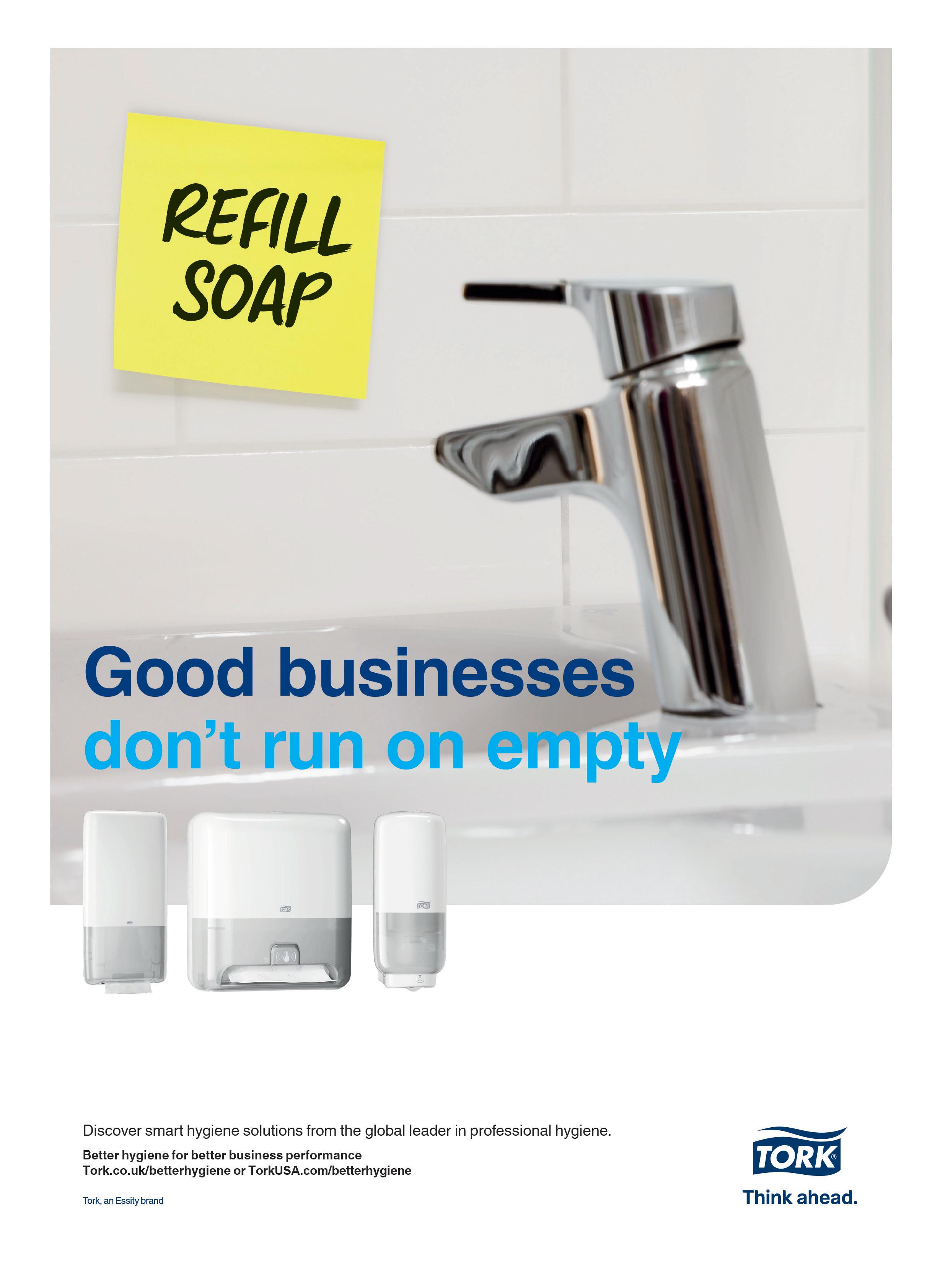
GETTING YOUR ducks in a row

a closed loop process around utilising CRM, email marketing and social media tools to maximise their results.
VENDOR SPECIAL Special Issue
There are certain technology components independent dealers in the business supplies industry need to get right to succeed in today’s online world. But many are doing exactly that, Brian Bowerfind, President of Office Products and Contract Furniture at ECI Software Solutions, tells OPI’s Heike Dieckmann.
OPI: What’s your perception of the state of your dealer customers right now, given the many obstacles over the past few years?
Brian Bowerfind: I’ve said it many times before and I’ll say it again: the independent dealer channel continues to show significant entrepreneurial spirit in good as well as bad times. There will always be challenges, but excellent leaders understand how to think strategically and execute on plans which are typically fluid in nature.
I believe the pandemic helped our industry in a roundabout way. Anyone who led an organisation through that period had to demonstrate the ability to figure out what was working and expand it, what was not working and stop it, and what needed extra care to move in the right direction. Those who understood this flourished and came out the other end with a stronger entity. The ones that didn’t react and continued with business as usual are probably no longer operating today or are in a seriously weakened position.
COVID-19 certainly placed a significant focus on getting just about any operator online. I would argue that the business supplies space has been well ahead of other industries from an e-commerce perspective over the past decade as regards the online customer experience, rich A+ content and robust SEO capabilities. Most dealers I speak with ensure they have
We recently conducted a study among dealers using our EvolutionX e-commerce platform – The Secret Recipe to B2B Ecommerce Success – with the aim to identify trends from those generating the highest revenue through their online store. We compared the top 20% of online revenue earners to the rest. For marketing tools specifically, the results were clear: dealers investing time in leveraging the capabilities are seeing a better return.
The top 20% have nearly three times the number of active promotions, for instance, including discounts and special offers. They also have five times the amount of quicklists/ favourites set up to help their customers purchase frequently bought items faster. In the past 12 months, EvolutionX dealers have recovered nearly £5 million ($6.5 million) in revenue from re-engaging abandoned carts.
OPI: What have been the most fundamental changes in terms of what your dealers require? How do you address those needs?
BB: The biggest change I’ve seen over the past few years is that dealers are selling or wanting to sell a much larger assortment of categories. Some of this was a response to the changing buying habits of their customers and some of it was just good old diversification of their business model.
They are asking their clients: “What are you buying that I’m not selling you?” Dealers’ ability to react profitably to this question can play a significant role in their future success.
As a technology provider, it’s important our solutions support their model as it expands. One way we’re doing this is to ensure dealers’ e-commerce set-up can support any category they wish to move into. We achieve this by offering a highly scalable platform which allows them to consume as many manufacturers or wholesaler catalogues as they wish.
28 www.opi.net
Despite many challenges, progressive dealers are jumping on the technology bandwagon and, with the solutions on offer, are maximising the opportunities
INTERVIEW
Special Issue
TECHNOLOGY SOLUTIONS
Our dealers are now able to sell hundreds of thousands of non-wholesaler supported SKUs with ease. The term ‘endless aisle’ has been thrown around for years, but it’s finally becoming a reality.
Back to the study I’ve just mentioned, we found the most successful dealers have nearly double the number of total SKUs on their websites compared to those that are not doing so well. The wider your breadth of product offering, the more you’re likely to sell.
OPI: In addition to product scope and revenue, let’s talk about margins and profit. I believe ECI’s Margin Accelerator is the tool which generates results here.
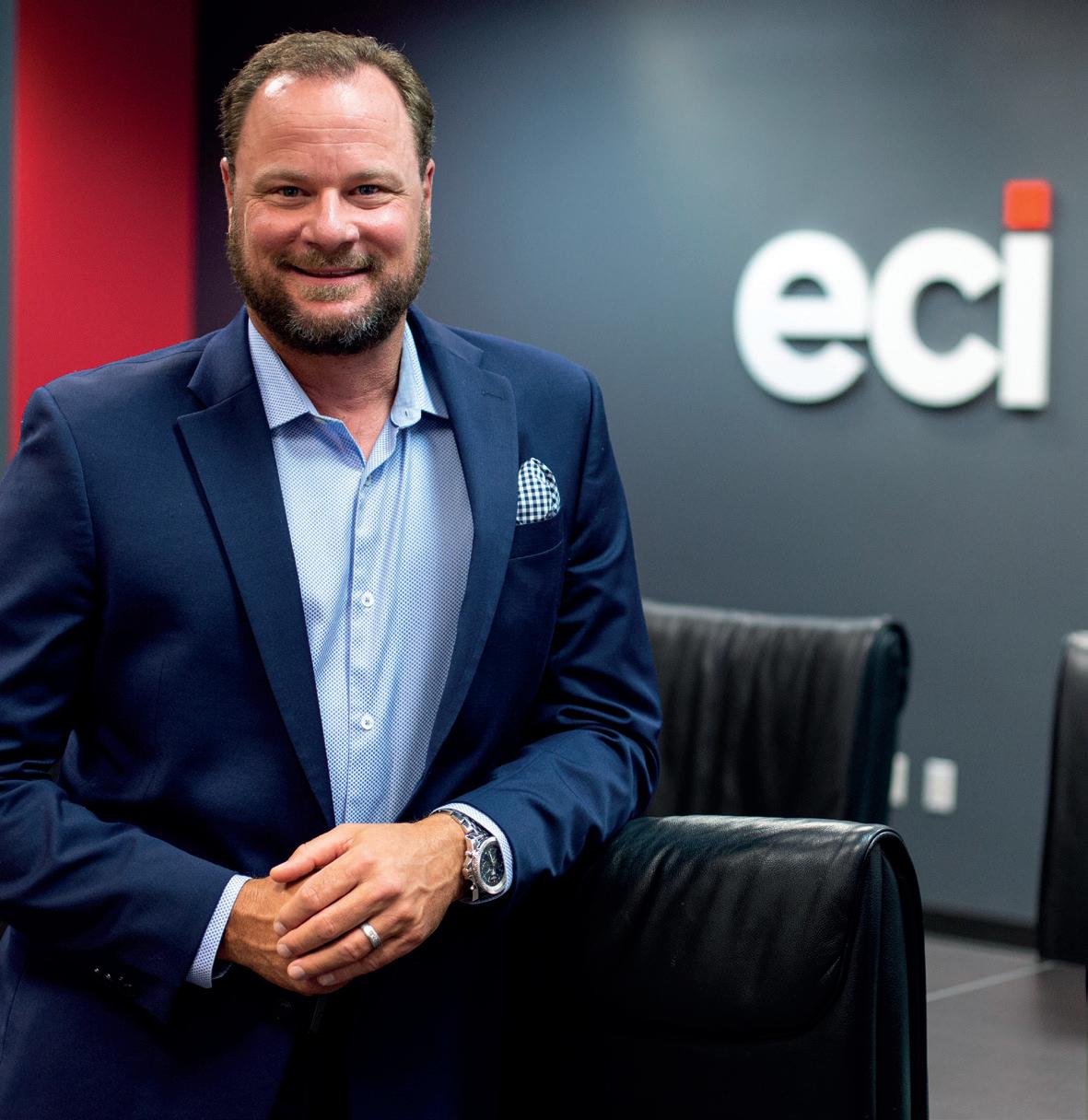
BB: It does. Margin Accelerator has brought an amazing amount of profit to dealers. We partnered with The InterBiz Group a few years ago to customise pricing plans for dealers so that they are simultaneously market competitive and much more profitable than they were before they engaged with us.
Each dealer is provided with a set of up to five matrices so they can quickly move margins up or down depending on the sensitivity of the customer. We also include profitability coaching at no extra charge, so dealers can quickly respond to issues arising within their businesses.
OPI: How savvy are dealers with dynamic pricing these days?
BB: To answer this question I think we need to look at the past. When ECI first created DDMS, it offered a very robust customer-specific pricing module. Each client could have multiple items held at a specific price for an extended period if necessary. In my experience, customers do not compare each price when placing an order; they are primarily concerned with certain benchmark items like copy paper.
That being said, over the years price scraping and focused marketing campaigns have led many dealers to minimise the number and size of customer-specific contracts because they consider them hard to manage. But in some cases, moving away from ‘custom contracts’ has hurt their competitiveness as well as their ability to please individual clients.
This challenge can only be solved by looking at all the options available to meet the needs of individual customers – while keeping margins. We help with this and very little work is required from dealers, so I think the time is right for them to become reacquainted with this sort of dynamic pricing if they’re not already.
OPI: You mention price scraping. How important is it?
BB: That’s an interesting one. Let’s start with Amazon. It changes prices multiple times daily,
so anyone who ‘scrapes’ the site would need to do it constantly. Independents don’t have the time to change their prices that often and, in my opinion, they don’t need to. The best operators are growing and one of the primary reasons is the amazing service they provide.
A customer recently said to me: “It’s not just about the last mile of delivery, everyone has that figured out. It’s about the last foot of delivery and 3PLs just can’t compete with what we can provide.”
As for scraping other competitors, there could be value, but they also change their prices quite often. Within the past few months, several dealers have called about Margin Accelerator, because big competitors have cut services, reps and prices. Some dealers have experienced margin degradation of over 30% because their price matching software has forced their pricing down with no sense of where the marketplace truly is.
Many dealers have figured out that they don’t have to provide the exact same price to their customers as their competitors do. It’s more about ensuring your end-user pricing is competitive where it needs to be while understanding what margin you require to maintain a healthy business.
September 2023 29 INTERVIEW Brian Bowerfind
Customers do not compare each price when placing an order; they are primarily concerned with certain benchmark items
Brian Bowerfind
FULL VISION
All resellers in our industry need a fully-fledged technology set-up with comprehensive support – it’s become a no-brainer. The issues dealers have to address under that broad umbrella are manifold, however.
What, for example, do they need to do about SEO ranking and overall digital marketing?
How can they remain competitive, ahead of the curve even, from a pricing perspective? What do end users demand from a customer experience perspective?
OPI’s Heike Dieckmann spoke to a range of software providers to get their take on where progress has been made, what’s important and which issues still need addressing.
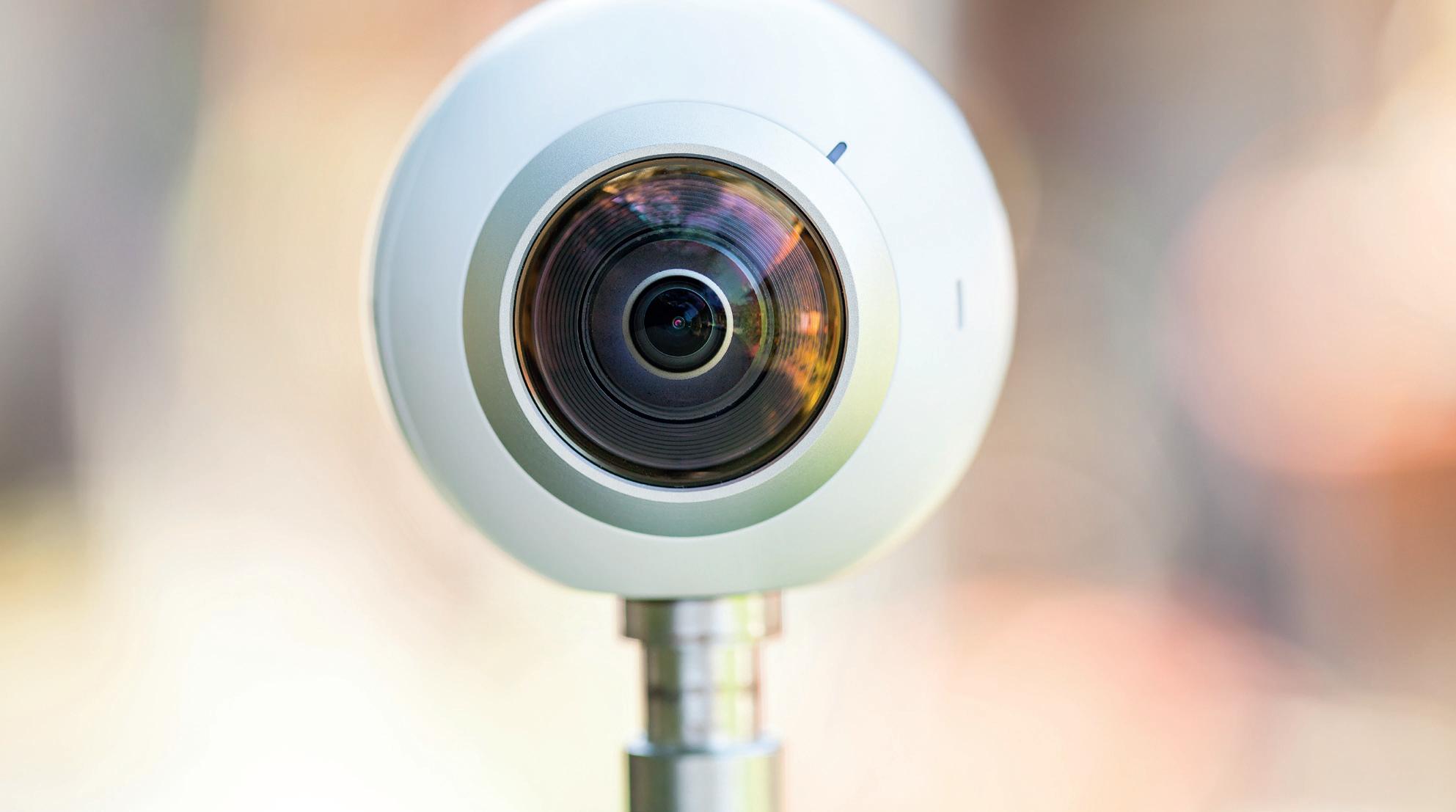
TECHNOLOGY SUPPORT – WHEREVER YOU WORK
ANDY BALLARD, DIRECTOR OF SALES, GOPD
When the COVID-19 pandemic hit and everyone was sent home, dealers found that the transition to remote or hybrid work was seamless with GOPD. All of our tools were online already, so as long as they had access to the internet, they could continue to do their job from home.
Customer service and purchasing were online and worked the same wherever the location. Dealers that needed multiple people working on their QuickBooks systems could move, if they didn’t use it already, to a GOPD-hosted server and access it from anywhere. Salespeople often worked from home anyhow and, with proper e-commerce sites in place, orders just flowed from the customer to the dealer to the wholesaler.
We developed several new tools for our clients, making it even easier to work remotely or on a hybrid schedule. The first one was a new e-commerce capability for sales staff. In addition to all the usual – product searches, specifications, customer history, favourites, etc – we added the capability to modify pricing, create quotes, save to the customer’s shopping cart, or release as an order.
We next added other service features: being able to change orders created by customers
VENDOR SPECIAL Special Issue
and salespeople; managing purchasing down to the item level including working with multiple sources; setting up customers; dealing with marketing such as coupons, and seeing orders based on status.
A Sales Manager Dashboard now gives owners, managers and reps the ability to see their analytics, comprising sales by customer, client-specific and overall numbers, category revenue and comparisons to previous years.
In addition to independent dealers being truly able to work from anywhere, they have the flexibility to hire the best candidates regardless of their location. And, of course, they have the option to save overheads by reducing office space.
COVID did not cause dealers to miss a beat in my opinion, and now they can enjoy the technology flexibility and advances providers such as GOPD have facilitated. Find out more: www.gopd.com
30 www.opi.net FEATURE
Special Issue
TECHNOLOGY SOLUTIONS
Software solutions providers are the helping hand – and often the voice of experience – that guide independent dealers through the maze of technology options
COVID did not not cause dealers to miss a beat in my opinion, and now they can enjoy the technology flexibility and advances
FULL MARKETING STEAM AHEAD
JENNIFER RAE STINE, PRESIDENT, FORTUNE WEB MARKETING
Dealers that previously sat on the fence about starting new marketing tactics or strategies have finally realised the urgency. They’ve learned that you never know what lies ahead in business – and the world in general – so they need to make sure their marketing is not only agile and flexible, but they actually have strategies in place to build upon and evolve with. Starting from scratch is not an option.
What I find really refreshing is that dealers which have been continuously innovating their marketing programmes are now looking to take it a step further – better e-commerce sites, integrations and new tools such as HubSpot. The push into new verticals and products/services, such as micro markets, is also a positive, as is the growing foray into the architecture and design market for furniture, breakroom and promo.
SEO and ranking is a perennial topic for anyone with an online presence. Everybody by now should have migrated to GA4, the new Google Analytics platform, following the retired previous version. Dealers always
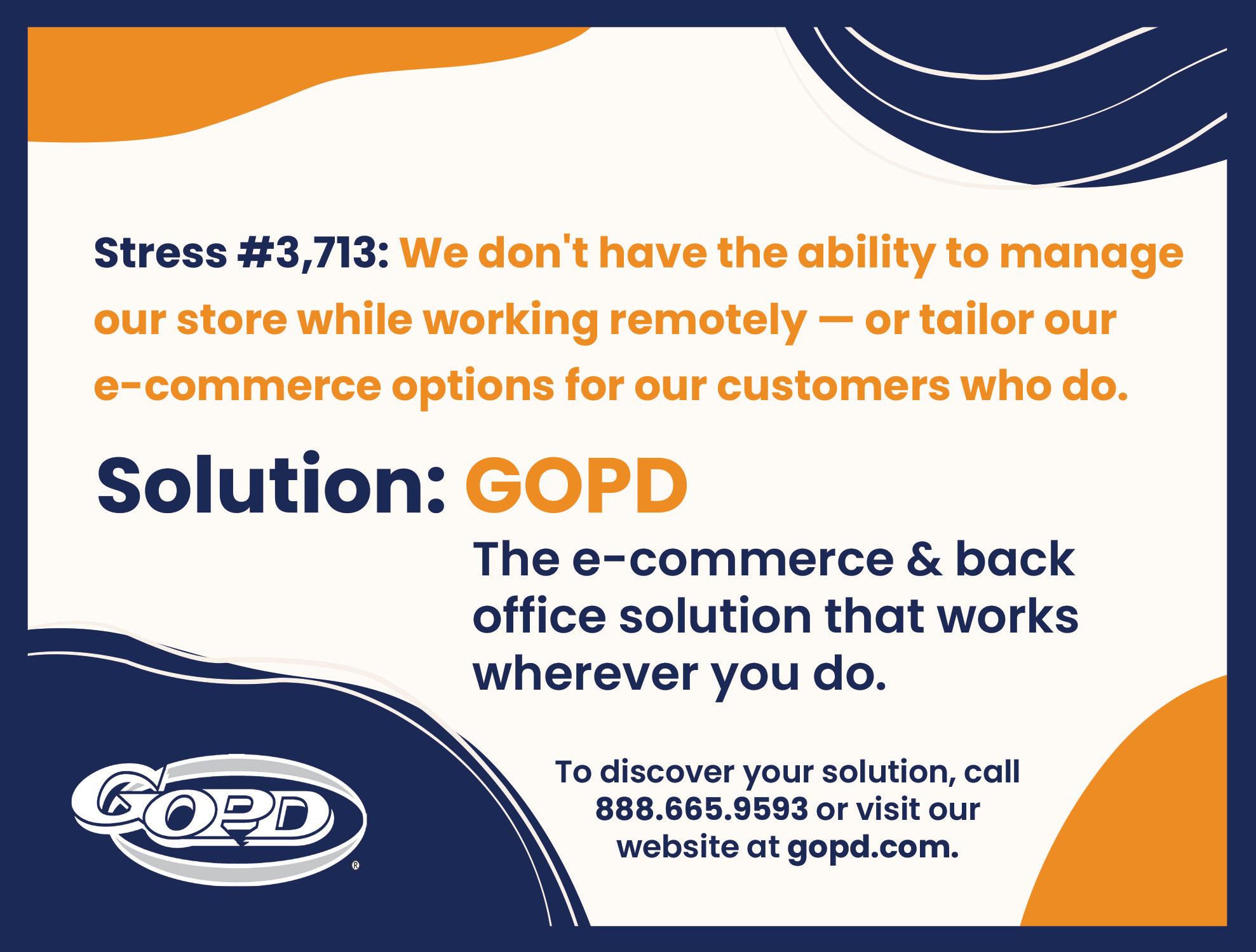
want to start with SEO, but most of them in this industry lack the budget and the patience it takes to rank highly. SEO is not a quick money-in-the-pocket tactic – you have to be in it for the long haul, with a consistent strategy.
Social media and email are still on the rise – often underrated in the business supplies space in my view – but a very important component of marketing. It’s particularly important given that buyer personas are shifting to a younger demographic. Find out more: www.fortunewebmarketing.com

September 2023 31 FEATURE Technology Solutions
PRICE MONITORING AND MARGIN MANAGEMENT
LAUREL LOEHLIN, PRESIDENT, BUSINESS MANAGEMENT INTERNATIONAL
Dynamic pricing is finally gaining traction. In the past, dealers’ entire mindset revolved around net pricing. Suggested net pricing is provided by the wholesalers, with dealers then oftentimes setting their own – for specific customers or groups of clients.
But it was all done manually. When costs changed, it was again a manual process to determine what to do and how often to do it. Profits were being left on the table because independents were not quick enough to react.
In order to plug this gap, Business Management International (BMI) created a tool called Margin Management. The functionality allows dealers to set criteria

ALL ABOUT THE CUSTOMER
ALEXANDER NICOLAIDES, PRESIDENT, LOGICBLOCK
EXPERIENCE
Customer experience is the name of the game. If your clients are not having a good experience when shopping with you, they will look elsewhere.
People pay more to shop big-box sites for a reason. Even a giant like Google factors in customer experience when positioning websites in its rankings. The refinement and improvement of these optimisations is an enduring task for us, one that requires continuous investment, maintenance and innovation. For example, we have been working with each of our customers to get their sites updated from legacy methodologies to the latest and greatest.
While some dealers have really taken advantage of the critical components of a comprehensive digital strategy, others have a way to go. All of the search engine marketing options are there, but they involve time and effort, two things dealers are not always happy to give. As such, it’s really important that their
so that, for instance, when vendor prices change, the software can change sales pricing to allow profit margins to remain intact. In the past year or so, the need for this option has become absolutely critical. With prices of virtually everything consistently on the rise, Margin Management becomes a ‘must have’.
In our new software version branded BMI SupplyAutomate – a complete re-write of our turnkey ERP solution for the business supplies and jan/san industries – we have improved on this functionality even more.
When the system creates purchase orders and the cost is put to a line item for a vendor, as we receive that product and the cost is confirmed from the vendor invoice, we now have a flag on the price schedules to allow Automatic Margin Maintenance to take place.
If the cost goes up, the system automatically recognises it and changes the sales price accordingly for select price schedules with this functionality enabled. Find out more: www.bmiusa.com
e-commerce service provider is modern in its approach to technology.
The most fundamental change we’ve seen in our dealer customers’ requirements is the need for seamless integration across various digital platforms. They demand robust EDI and API capabilities to optimise their business processes, which has led us to enhance our services and integration options.

Find out more: www.logicblock.com
For more on the customer experience, see also our Case Study on page 36
FEATURE Technology Solutions 32 www.opi.net
Dynamic pricing is finally gaining traction. In the past, dealers’ entire mindset revolved around net pricing
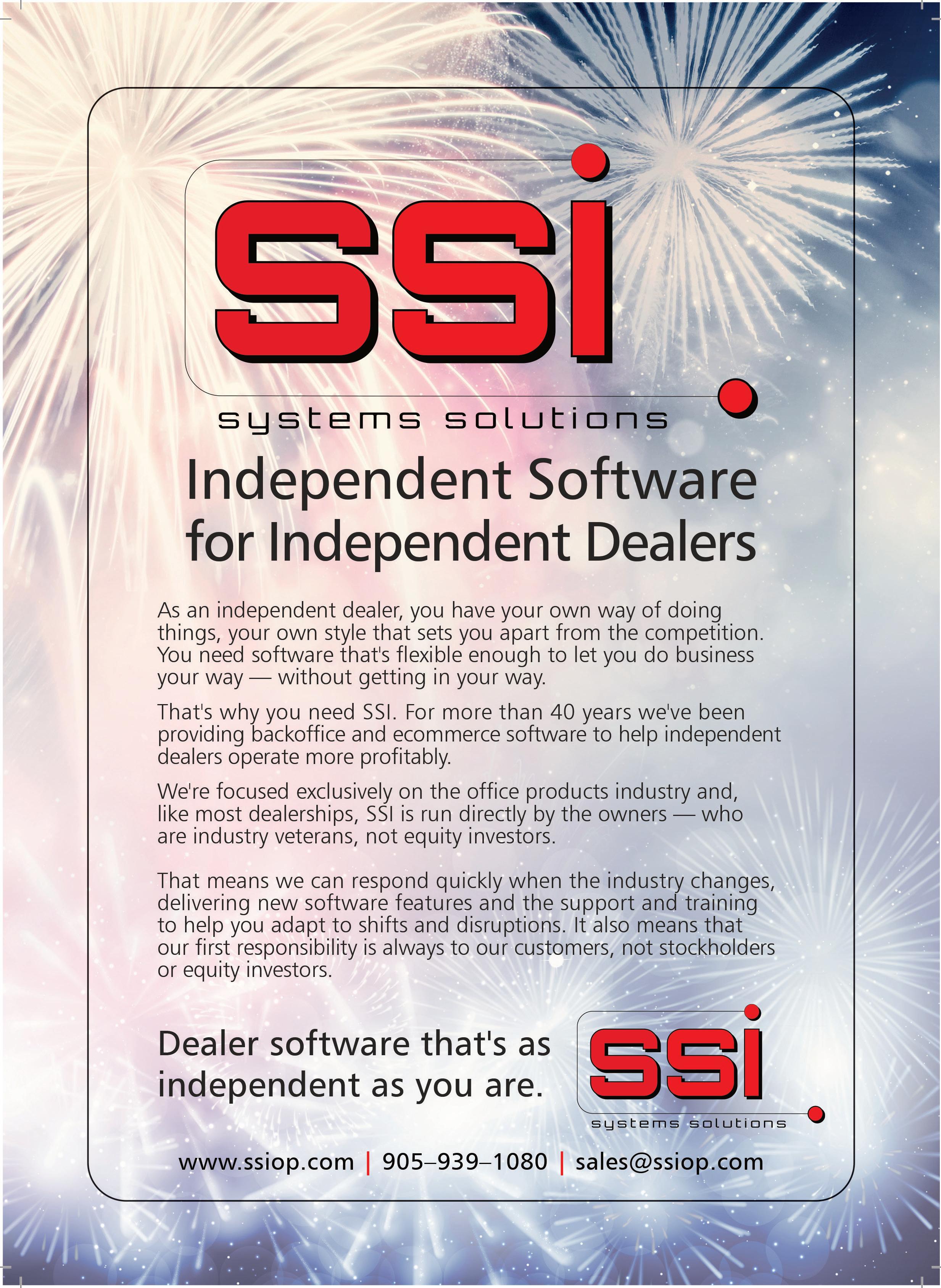
ARTIFICIAL AND HUMAN INTELLIGENCE: best of both worlds
Look at any business publication or website, research reports or indeed any medium of generic news coverage – artificial intelligence (AI) is everywhere (see also Spotlight, page 40) Or talk thereof at least. The business supplies industry is constantly on the hunt for cost efficiencies and automation, in the name of making life easier and more profitable for all channel participants – and the end customer, of course.
So what do some of the main protagonists in the software solutions space think of the potential of AI? Find out below.
CHARLES RUSSELL, CO-OWNER AND COO, SSI
AI has a lot of potential for customer service. We’ve started looking at it and thinking about how we could use it in our software – AI-based order entry, for example, that lets you enter orders verbally. But, if you think about it, AI is only going to answer questions as well as the customer asks them. For AI to work, you are going to need really good databases. Building ones that are complex enough to be useful is going to take a while.
JENNIFER RAE STINE, PRESIDENT, FORTUNE WEB MARKETING
We use AI tools such as Anyword for the paid ad side of things. We firmly believe you need a human to review and tweak anything that comes out of AI. Only a human knows the ins and outs of the topic and can better put the content in the customer’s brand voice. AI cannot.
Our AI tools are great in that they help our staff work smarter, not harder, and this is what we use them for. We have also used AI-generated imagery on some campaigns, but here too, you have to be careful. It only works if you can edit the ‘weirdness’ – fingers that appear melted together, teeth which appear as just white blobs or images looking completely out of proportion.
Overall, I think with careful application and review, AI can be helpful, but it’s never the complete answer.
ALEXANDER NICOLAIDES, PRESIDENT, LOGICBLOCK
AI is becoming increasingly important for optimising customer experiences and improving operational efficiencies. It can assist with data analysis, customer service through chatbots, and personalised marketing.

All that said, there is a need for proper implementation and management to maximise the benefits and minimise potential downsides, such as data security issues.
Also, once AI-enabled software does become available, dealers are going to have to be careful how they use it. Using AI to generate end-user marketing is an example. If you have multiple dealers in the same market all doing this, it could end up as a battle of words going back and forth.
An even bigger concern is if those dealers are marketing on pricing with AI in control, especially if the lowest price is the main criterion. You could start getting a 5-10% margin where you could have made 40%, either because AI lowered the price or sold the customer a name brand the dealer has to order instead of the generic item it has in stock and makes a profit on. It’s certainly a big work in progress.
PADDY DONNELLY, BUSINESS UNIT LEADER, ECI SOFTWARE SOLUTIONS
Today, we’re covering the ‘low hanging fruit’ – scenarios such as blog post creation, for instance. However, in the near future we intend to extend this to all content areas of the platform, including automatic marketing copy generation for product descriptions and email templates. Looking further ahead, there is potential to drive AI-based product recommendations and even design.
We see tremendous application for the technology, fused with the power of EvolutionX, to create game-changing experiences for our customers as AI continues to mature.
FEATURE Technology Solutions 34 www.opi.net
AI is only going to answer questions as well as the customer asks them
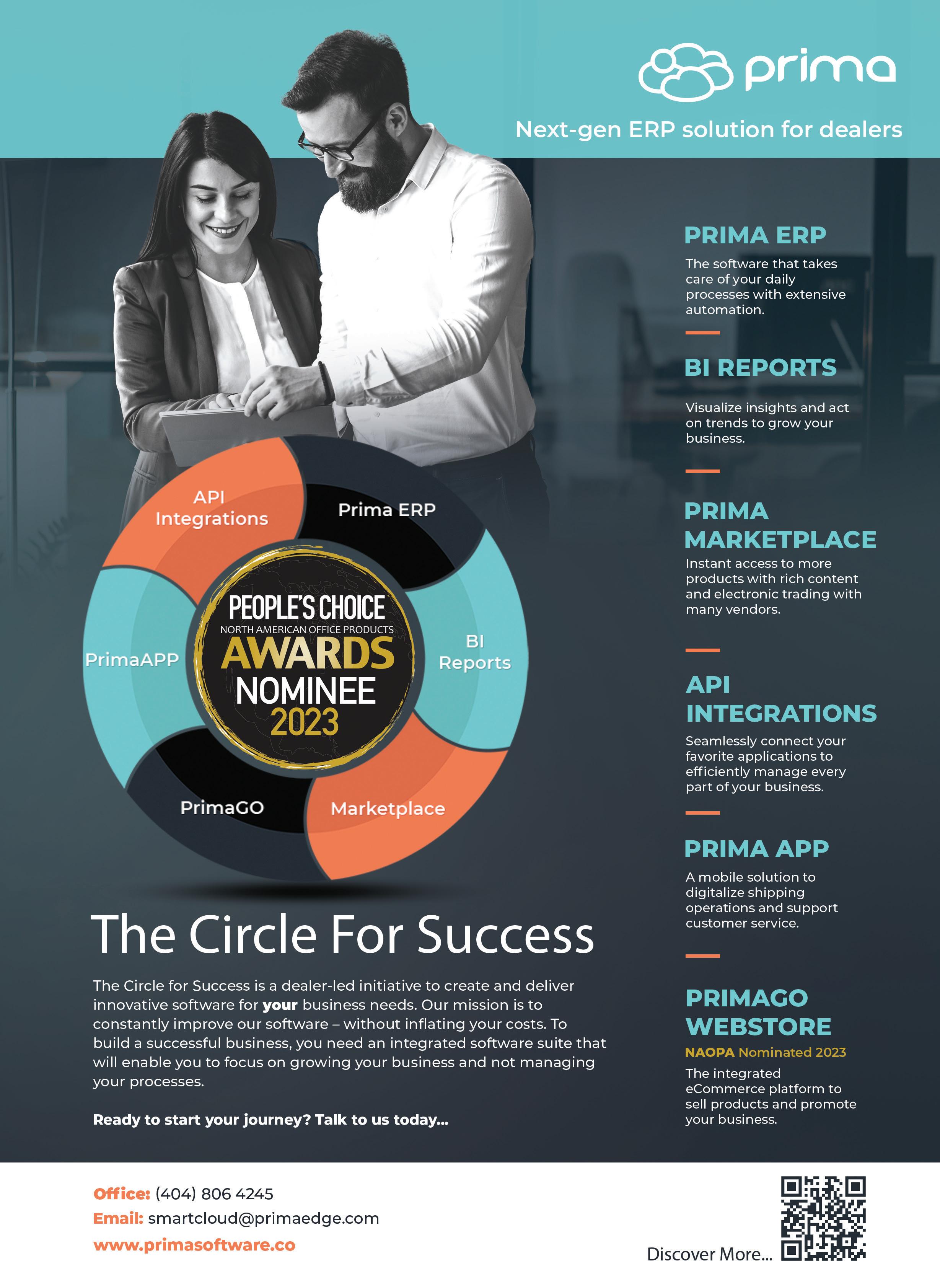
Hitting the TARGET
Founded in 1880, Egyptian Workspace Partners is located in Belleville, Southern Illinois – a region known as ‘Little Egypt’. Under the guidance and leadership of CEO Brett Baltz, the dealership now turns over $7-10 million a year. It serves the St Louis, Missouri, region and beyond, doing business with a variety of organisations, including SMBs, schools and federal government institutions.
Egyptian sells office products, but its main division, as a Steelcase dealer, revolves around furniture, with dedicated project designers on its staff.
Just before COVID-19 hit, the company bought Talis IT Partners – a technology company specialising in AV equipment, managed services and IT support. This allowed it to branch out in a whole new direction, selling everything from laptops to complete conference room set-ups with integrated touchscreen panels, camera systems and monitors.
It’s now the fastest-growing division and Baltz puts this down to being a one-stop shop. “Small- and medium-sized companies just want a single set of people to deal with. They don’t like communicating with a variety of suppliers, and our offering makes it super easy for them,” he says.
The company’s history from a tech support point of view is quite colourful, starting off with ECI’s DDMS, followed by MBS Dev, run
by Essendant (United Stationers at the time), but spun off in 2014 and sold to Enavate. What ensued was a period of technology challenges, so much so that Egyptian sought a new software provider just over a year ago and settled on Logicblock.
POSITIVE SWITCH
The steady switchover process was expedited in March of this year following the cyberattack on first-call wholesaler Essendant which led to a system outage of the legacy MBS Dev program. The time had come to cut old ties and go live with Logicblock’s 7cart e-commerce platform.
Baltz has been delighted with the results so far. “There was nothing wrong with the back end of the system we had before, but the front end was not fit for purpose anymore – it was an online ordering platform rather than a true e-commerce solution. Logicblock’s 7cart system now gives us unlimited control over our storefront. It also provides an excellent end-user experience, something we felt was previously costing us business.”
He explains: “We weren’t able to do proper marketing and were simply sending out flyers or using online ads to drive people to the website. Then the call to action was to ring us or meet up with a sales rep.

“This approach has completely changed to a self-service model where customers easily order items online. It did involve customising

36 www.opi.net
A change of software provider has opened up new opportunities for Egyptian Workspace Partners, revolutionising the way the company interacts with customers and freeing up time to grow sales – by Heike Dieckmann
CASE STUDY
Special Issue VENDOR SPECIAL Special
TECHNOLOGY SOLUTIONS
There was nothing wrong with the back end of the system we had before, but the front end was not fit for purpose anymore
Issue
Brett Baltz

the Logicblock package so it would operate in the right way for us. We don’t ship every item to all parts of the country, so design tweaks needed to be made. The system now asks for your zip code, for example, and tailors the items it shows based on your address.”
TARGETED SALES CALLS
On the self-service note, Baltz says one of the biggest benefits is that customers can manage their own account details, changing their address and payment details where necessary, for instance. Previously, such tasks had been the remit of the company’s own admin team.
“Additionally, we don’t need so many salespeople to drive customers to the website which cuts costs. We still retain some traditional sales roles to deal with referrals, repeats and long-standing customers who prefer a more personal approach. We have staff who deal with enquiries across our three divisions – OP, furniture and tech – but we also have specialists in each to deal with specific requests.”
are examples. Baltz adds: “We’re also thinking about adding Ingram Micro and including Steelcase items in our webstore. We get a lot of organic traffic to the site from people looking for Steelcase products.
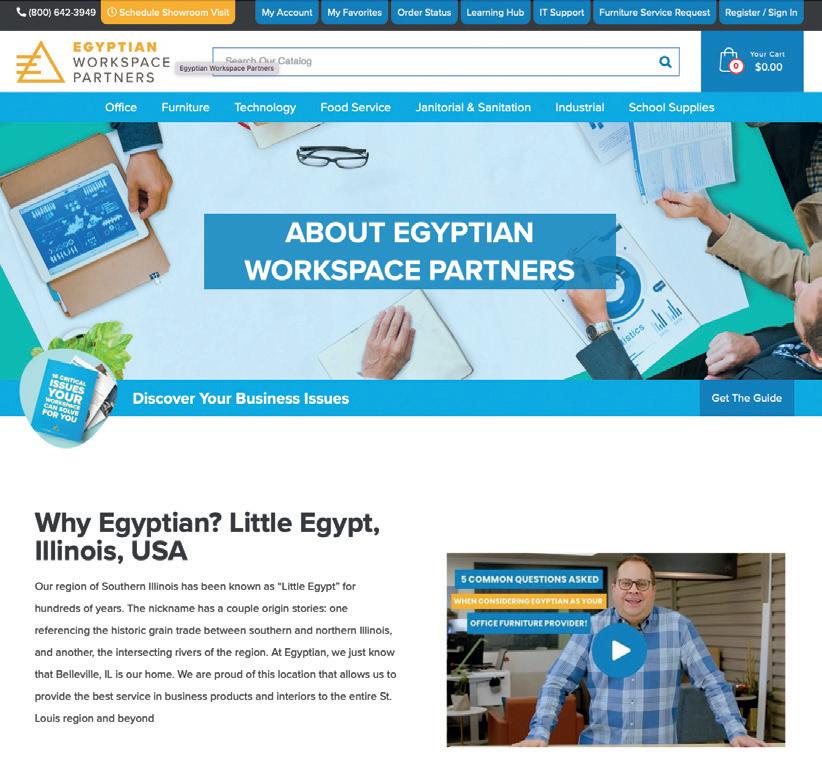
“We’re pretty prolific with online content now – I’ve published over 100 different blogs about seating, for instance – costs and other factors you need to consider when buying a chair, comparison tools, etc. All of this helps to convert general Steelcase browsing into specific chair sales – with no salesperson involvement required.”
Getting the right audience to look at its website is key, notes Baltz: “I’m very specific about the type of account we’re trying to target. We can now be more sniper-ish, targeting those we are really after in a focused manner.
“We’ve had some success with this recently – by checking the pages customers had been searching, identifying the types of products they were clearly interested in and then proactively reaching out to them to say ‘let me help you find what you’re looking for’.
“With this information to hand, the follow-up sales call is a lot easier. Both the conversion rates and quantity of items ordered are on a growth trajectory. This kind of approach would not have been possible previously.”
Abandoned carts is another component Baltz and his team are looking at: “What triggers do we need to set up to alert a salesperson that someone logged in, but didn’t complete the order? With our current system, we can review a potential customer’s search history and initiate a follow-up call, rather than just sending an automated email which we’ve not found particularly successful in the past.”
The new software also makes it easier to onboard other distributors and vendors –Clover, Liberty Laser Solutions and Arlington
Bulk purchases through direct links with manufacturers are another component Egyptian puts its emphasis on right now. “Historically, we’ve not been very good at transactional sales like this, but we’re trying to fix it. I’ve got a list of about 30 vendors we’re working with, trying to get their custom catalogues integrated into Logicblock.
“It would mean customers looking for purchases can just go to our webstore and immediately buy what they need – rather than making a request and us sending them a quote which might take several days to turn around.”
SUPPORT AND SUCCESS
Behind-the-scenes support from Logicblock is excellent, according to Baltz – and infinitely better than what the dealership had experienced before – in terms of speed of response, supplementary how-to tutorials, etc. “I’m impressed with how quickly they react and fix open issues. If it’s vital, it will happen on the same day. I’m not used to this kind of backup and it’s very reassuring.”
Most importantly perhaps, feedback from customers has been very positive. “Growing sales is the next stage,” Baltz concludes. “I’ve now got so many more tools at my disposal. I also have more time to devote to it, because all the tasks I used to have to do manually are automated. I’m loving it.”
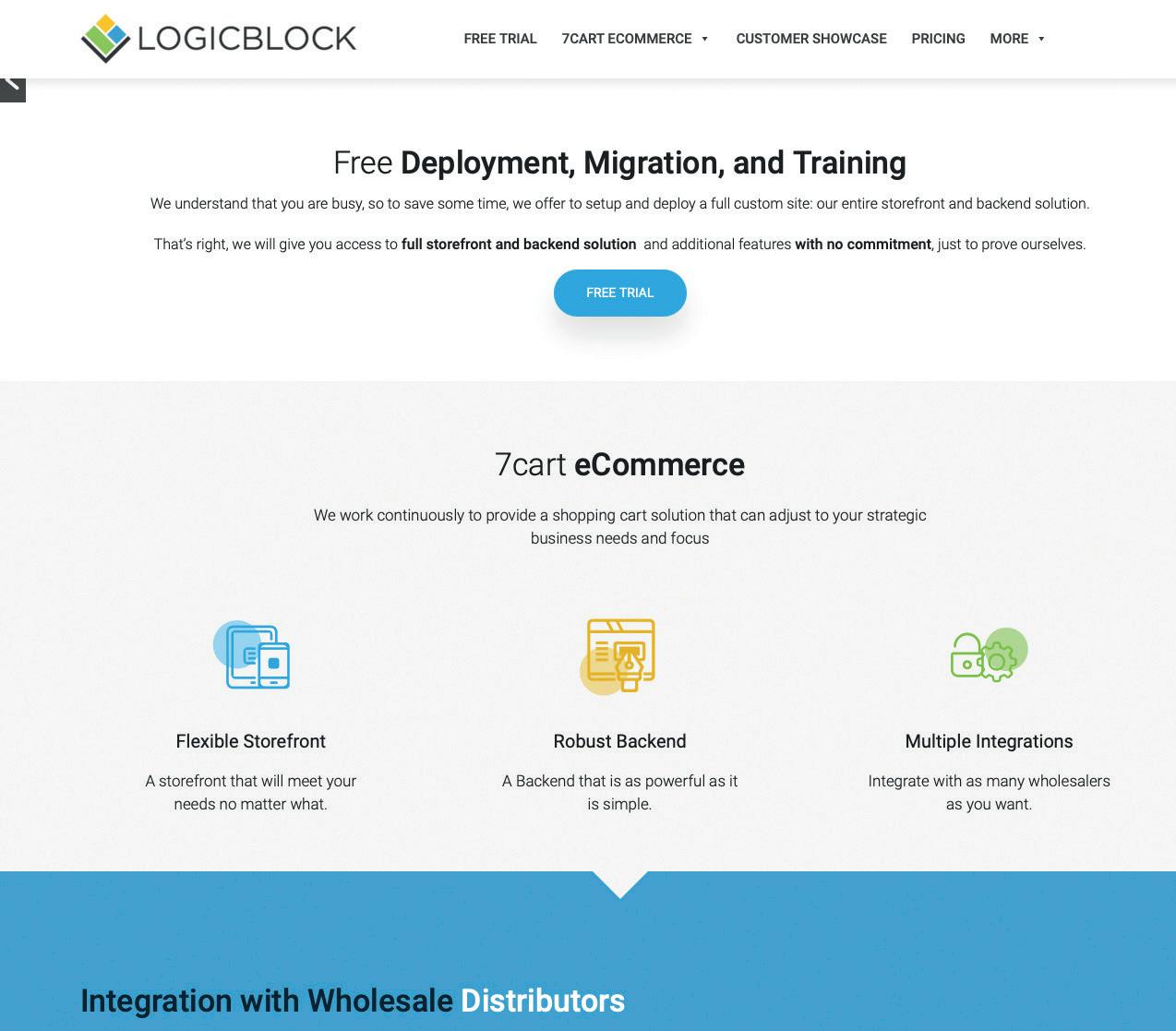
CASE STUDY Egyptian Workspace Partners 38 www.opi.net
We can now be more sniper-ish, targeting those we are really after in a focused manner

AI: FRIEND or FOE?
Artificial
The phrase ‘latest technological advancement’ has been used more frequently than ever as the digital age keeps leaping forward. There’s been progress in 3D printing, quantum computing and virtual reality over the past few years, but it’s artificial intelligence (AI) that’s been grabbing all the headlines since ChatGPT was released in 2022.
According to Andrew Mawson, founder of consultancy firm Advanced Workplace Associates (AWA), AI is a broad church and ChatGPT is an important branch of it that business leaders have to think about.
But, he warns: “Don’t leave all this to your CIO. You, as a leader, need to understand it completely to take advantage as opposed to being the victim of it. AI applications will be easy to deploy, with less need for programming skills and they’ll become economically viable faster than most executives imagine.”
STARTING POINT
AI research laboratory OpenAI launched ChatGPT – or Chat Generative Pre-Trained Transformer – in November 2022 and perceptions of what’s possible with the technology are changing all the time. The chatbot is based on an upgraded version of GPT-3 – released by OpenAI in 2020 – and it was the first time such a tool was made publicly available through a free, easy-to-use interface.

THE SHORT HISTORY OF OPENAI AND CHATGPT
November 2022: OpenAI releases ChatGPT
Different to earlier chatbots, its natural language processing software means it’s capable of human-like conversations while generative AI algorithms can create various types of content. It was an immediate success. ChatGPT reached 100 million users in only two months and, although it does not have a net worth in the traditional sense, OpenAI has an estimated value of $29 billion.
FEAR FACTOR
Naturally, there are fears. Many are questioning whether it would eventually replace humans (see Final Word, OPI July/ August 2023, page 48), for example. Also, the reliability of its information and the safety of it is an ongoing concern. Even OpenAI has admitted to flaws that developers must correct and users should safeguard against. An attempt to fix some bugs was GPT-4, released in March 2023. “GPT-4 is 82% less likely to respond to requests for disallowed content and 40% more likely to produce factual responses,” states OpenAI.
The conversation surrounding AI as a broad concept is ongoing as organisations are only
January 2023: ChatGPT reaches 100 million users, making it the fastest-growing application in history; Microsoft announces multibillion-dollar investment in OpenAI
March 2023: OpenAI announce GPT-4 April 2023: Germany launches data protection inquiry over ChatGPT and is back in Italy after meeting regulators’ privacy demands
40 www.opi.net
intelligence has evolved to become a part of everyday life since the launch of ChatGPT, but what does it mean for the business supplies industry? OPI’s Kate Davies finds out…
SPOTLIGHT
OpenAI has admitted to flaws that developers must correct and users should safeguard against
Special Issue
Special
TECHNOLOGY SOLUTIONS
VENDOR SPECIAL
Issue
beginning to dip their toes into its possible applications. In the process, a wide array of pros and cons are being discovered as abilities are applied in different ways.
One example is Nemo Office Club which has been incorporating AI into its support services and marketing initiatives. The UK dealer group says some of the current challenges could even lead to new roles in security and complaints divisions. As Marketing Manager Alan Calder notes: “All problems become an opportunity to create resolutions. We are being very cautious right now because AI is still an unknown.”
VENDOR SPECIAL Special Issue
VENDOR SPECIAL Special Issue
Productivity is an area where AI will likely come into its own. According to the IBM Institute for Business Value, 48% of CEOs say productivity is their leading concern and regard AI as a potential asset. Employees also see the benefits. Recruitment agency Aspire found 45% of people polled think ChatGPT and similar AI will help them perform their jobs better. Some examples include:
• Sales reps required to manually transcribe meetings and sales calls. In these scenarios, AI tools could programme software to recognise certain words and automatically generate notes.
• Product designers can use AI to quickly generate thousands of design solutions based on the product’s requirements and identify the top options. Human contributions would then determine the best solution.
• Marketing channels can be managed 24/7 by AI since it has mastered natural speech. This means marketing teams can keep customers engaged regardless of time zones.
10 MILLION
ChatGPT queries every day
$137 BILLION
Size of the global AI market in 2022
$1.8 TRILLION
Size of the global AI market by 2030
“AI will be used to automate rules-based jobs. Those left in ‘office’ roles will be people who think for a living. They will use AI tools that make them productive and, in some cases, better at what they do,” Mawson states.
SAFETY FIRST
While AI presents a whole host of opportunities, there are pitfalls to be dealt with before the technology can be fully integrated into the working world. According to Darktrace – a leader in cybersecurity AI – 74% of active customer deployments have employees using generative AI tools.
The fast pace in which AI has evolved led UK government agencies to issue guidance about the need to manage risk when utilising it in the workplace. Other regulators globally are expected to do the same to offset the chance of data leakage and security threats.
Copyright is another potential problem, given AI adapts pre-existing content that could be presented as original. It can also portray incorrect information as fact. With ChatGPT in particular in mind, for instance, US law firm Levidow, Levidow & Oberman recently found itself in hot water when it filed a brief written by the bot which was full of false legal precedents. ChatGPT had simply invented six cases.
The lawyer in question said he “never imagined it would produce fabricated content”. Federal judges have since issued standing orders requiring lawyers to certify their filings were created without generative AI or that a human reviewed the accuracy of any AI input.
As a result of incorporating the latest AI advancements which make job reassessments like these possible, the total percentage of hours that could be automated is as much as 70%, notes research firm McKinsey. However, AI only creates the potential to increase labour productivity. The next step is perfecting the rate of technology adoption and redeploying worker time effectively.
Action has also been taken to safeguard against wrongly applied AI more generally. In June, the European Union (EU) agreed to amend the EU AI Act and regulate it in areas including infrastructure, product safety and places it could be used to generate ‘deepfake’ content or cybersecurity threats. European companies quickly shared fears about the restrictions in an open letter signed by around 160 executives stating further legislation would “jeopardise Europe’s competitiveness and technological sovereignty”.
GETTING ON BOARD
Technology has been changing the working landscape for decades. It never happens overnight, but it’s vital that industry leaders make some important decisions about AI now.
SPOTLIGHT Artificial Intelligence September 2023 41
Those left in ‘office’ roles will be people who think for a living
May 2023: OpenAI CEO calls for new AI regulatory agency to protect against its misuse; OpenAI reaches a presence and support network in 163 nations
June 2023: Over 100,000 ChatGPT credentials are leaked and users are urged to change passwords
July 2023: ChatGPT is available for Android; Apple tests generative AI tools to rival ChatGPT
Special
TECHNOLOGY SOLUTIONS
Issue
DATA AND CONTENT: a work in progress
In the rapidly evolving business supplies industry, data and content management has emerged as a persistent challenge for independent dealers. The organisation and utilisation of data can provide a competitive advantage, but many dealers struggle to harness its full potential.

THE CHALLENGE
Our industry is highly dynamic, characterised by a vast array of products, changing customer demands and many suppliers. These factors pose significant challenges for dealers in terms of acquiring and managing data and content. Some common hurdles are:
• Data integration and accuracy: integrating data from diverse sources such as vendors, inventory systems and e-commerce platforms can be complex. Inconsistent data formats, errors and gaps in information make it difficult for dealers to maintain accurate and up-to-date product catalogues, pricing and inventory levels.
• Data availability: dealers frequently encounter limitations in receiving specific vendor data through their existing sources. Even when they do have access, the process of requesting and sorting data is highly manual.
• Competitive intelligence: having access to market trends, competitor insights and pricing information is crucial in enabling independents to make informed decisions. However, collecting, analysing and interpreting this data manually is time-consuming and prone to errors, limiting their ability to react to market dynamics.

ADDRESSING THE ISSUES
Despite the challenges, our sector has made considerable progress in addressing these issues. Technology can help to simplify the
integration and standardisation of data from various sources. Automation tools, data connectors and application programming interfaces, for instance, enable technology providers to centralise and normalise their data, improving consistency and accuracy. Cloud platforms, meanwhile, also offer scalable and cost-effective solutions. Independents can leverage these systems to store and access their data securely, collaborate with suppliers and streamline content creation and distribution processes.
Finally, artificial intelligence and machine learning can be leveraged to automate data analysis, product classification and content generation. These intelligent systems will automate a lot of the work required to categorise products, extract key attributes and suggest relevant content – saving dealers time and cost.
SEAMLESS INTEGRATION
Prima Marketplace serves as a centralised hub that aggregates product data from multiple suppliers. We take care of the legwork by reaching out and collaborating with new vendors, acquiring their catalogues and providing a data stream for dealers which have an account with the respective vendor.
The result is no unavailable or discontinued items, fewer refunds and an all-round positive customer experience. Dealers’ ERP and e-commerce platforms are updated with the most up-to-date product listings.
The software also allows dealers to efficiently organise, enrich and update their own product content and provide custom data updates to their customers via their webstore and their own Prima Cloud ERP.
We offer e-commerce solutions powered by S.P. Richards, Essendant and Prima search, providing a range of options for businesses seeking tailored online sales. Dealers can leverage standardised templates, automate content enrichment, and maintain consistency across multiple sales channels.
By combining data from Prima Marketplace and their Prima ERP, dealers can access market trends, live pricing, inventory information and get competitor insights. They can then make informed decisions, adjust pricing strategies and stay competitive in a fast-changing market.
42 www.opi.net
OPINION
Technology can help to simplify the integration and standardisation of data from various sources
TECHNOLOGY SOLUTIONS Special Issue Special Issue VENDOR SPECIAL Special Issue VENDOR SPECIAL Special Issue VENDOR SPECIAL Special Issue TECHNOLOGY SOLUTIONS
Steve McLaughlin, CEO, Prima Software

PRINTING pressures
David Holes
The fallout from the pandemic continues to affect the print and imaging market. Feedback from those operating in the field reveals that sales have not recovered from pre-COVID volumes, partly due to the persistence of the hybrid or work-from-home (WFH) phenomenon. Alongside this, there has been a shift away from laser towards inkjet printers as it is what home-based workers prefer.
Print research organisation Quocirca reports that current print volumes are flat or declining. As such, many businesses involved in this area are diversifying into adjacent areas, including IT services and sustainability-led solutions, to develop future revenue streams.
That said, its Future of Work 2025 study shows print is still viewed as important to 72% of key decision-makers, indicating a large number of companies remain reliant on this product spectrum to support business processes. Therefore, the challenge is to deliver flexible, innovative and secure print services which support hybrid workplaces.
Print management software developer
PaperCut says the continued decline of office print volumes is driven by long-standing company policies encouraging staff to think twice before printing. Steve Holmes, Global Head of Sales & Channel and EMEA General

Manager, remarks that the move to hybrid working has accelerated this: “With staff operating remotely, office-based devices are often underutilised, driving reductions in related ink and toner purchases. Customers are also keeping devices 20% longer on average, looking to extract as much value as possible from their assets.”
Those nimble enough to adapt are benefitting. Guy Gash, Business Development Manager for Managed Print at print wholesaler CTS Toner, says the pandemic forced it to accelerate the diversification of its offering as customers demanded support for staff based at home. “Unsurprisingly, ink sales grew to support the surge of smaller desktop machines being purchased. With many employees not returning to the office full time, these volumes have continued to increase, leading to an expansion of all of our consumable product ranges.”
MARKET AFTERSHOCKS
At Print-Rite Europe, CEO Steve Weedon agrees new ways of working have had an impact on consumable sales, driven primarily by lower office-based demand.
He paints a somewhat depressing picture: “Aftermarket consumable margins are down as the market races towards those
 Steve Holmes
Steve Holmes
44 www.opi.net
Falling sales, new working practices and security threats all combine to put the MPS, print and imaging industry under considerable pressure –
CATEGORY UPDATE
by
offering the lowest prices. Chinese cartridge manufacturing output has slowed, leaving fully-automated plants running at less than 50% capacity.”
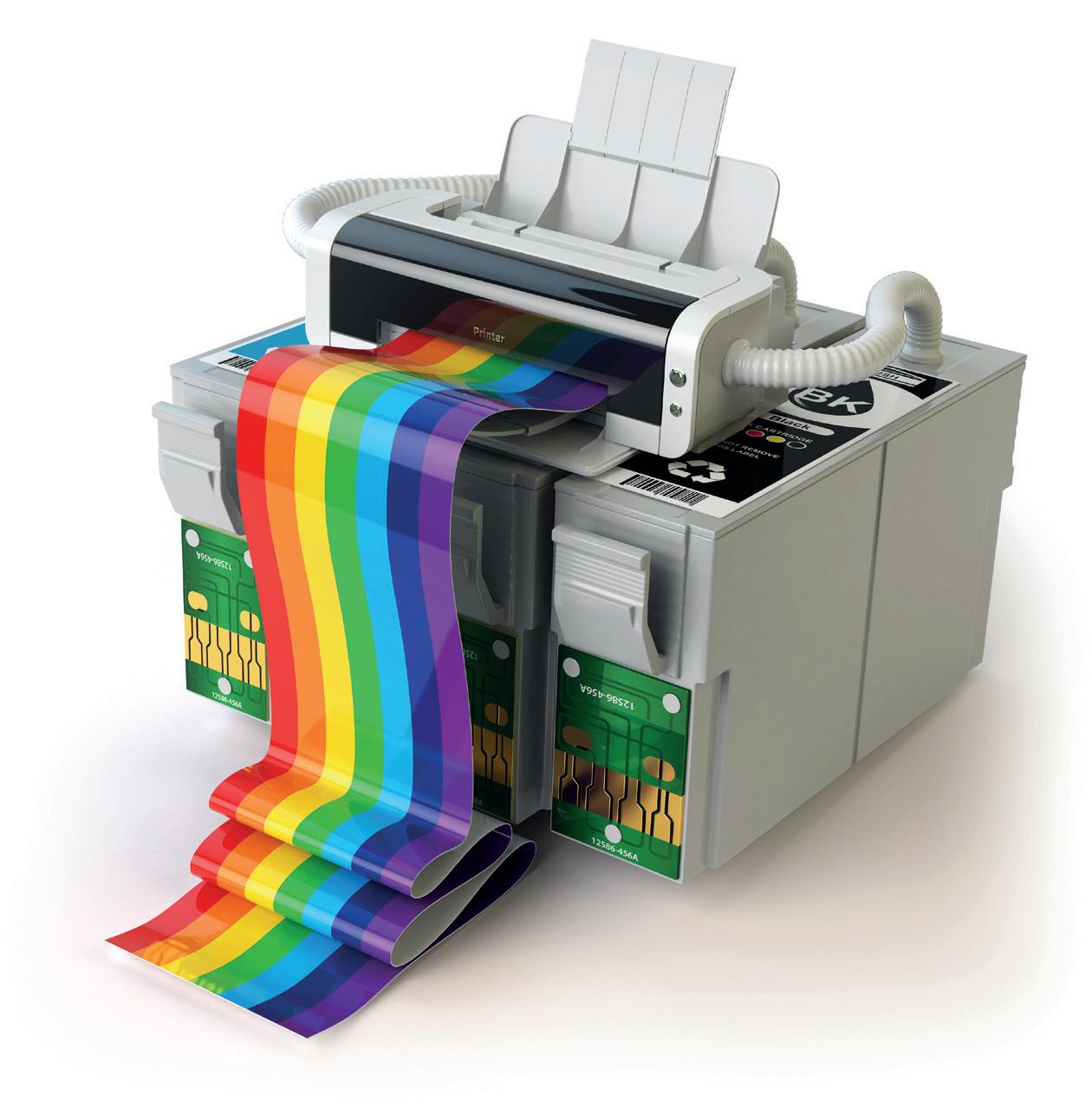
He adds that the current Ninestar Group US import ban on certain products – based on the accusation of using forced labour in violation of the Uyghur Forced Labour Prevention Act –has also started to bite, with Lexmark trying to distance itself from the group. “The knock-on effect will be deep for Ninestar and likely for Lexmark too, not just in the US, but also in Europe where we already see buyers switching to alternative vendors.”
providing cloud print services, alongside consultancy to support them, is becoming a critical component of a supplier’s offering.
PaperCut’s Holmes cautions that hybrid print presents potential pitfalls, as the best office practices don’t always carry across to home environments and security issues can be hard to manage. “Documents sent to home printers can be anything from recipes to homework or bank statements. Getting a confidential work-related document mixed up with these and falling into the wrong hands can happen very easily,” he says.
“Most offices have a shredder or other means of disposing of them responsibly. However, home documents are probably thrown away with the rest of the rubbish, posing a potential security issue.”
Distribution Management – parent company of US imaging and equipment distributor Supplies Network – is more bullish, with MPS Sales Manager/Business Development Jason Moore saying print volumes are returning to pre-pandemic levels due to people going back to the office.

“While mono printing volumes remain flat, colour has experienced 27% growth. As colour pages are significantly more expensive, this has resulted in revenue increases,” he explains.
“We’ve also noticed this growth is coming from fewer devices. The pandemic seemingly weeded out some lower-volume printers, with the bulk of pages now being driven through fewer, more cost-effective machines.”
Additionally, the company is witnessing an uptick on the contractual side of the category, with manufacturers rewarding partners with more aggressive equipment and supply pricing. Moore notes: “Transactional sales will always be there, but end users will be charged more than they would under a contract.”
CLOUD PRINTING GROWTH
Hybrid working is creating challenges for organisations in terms of how they manage secure printing for both remote and office workers, according to Quocirca. This is boosting momentum in the cloud print market as it enables organisations to centrally deliver and track print usage across multiple locations.
Its research shows investment in this area is a top business priority – while 31% of companies already manage their print environment fully or mostly in the cloud, 55% expect to do so by 2025. Consequently,
Changing working practices have additionally affected printing habits, with evidence suggesting employees don’t need – or want – to print so much at home, often delaying the generation of hard copies until they’re next in the office.
Ian Silvester, Director of Product Management at MPS software supplier EKM Global, refers to this phenomenon as ‘burst printing’ which causes a spike in the requirement for consumables on those days when employees are required on site.
He adds: “Print-anywhere solutions are also in increasing demand with the rise of remote working and dependence on mobile devices. Customers require MPS technologies that support them wherever their location, including the ability to produce paper copies directly from a range of smartphones and tablets, with secure print release options gaining traction.”
CATEGORY UPDATE Imaging Supplies/MPS/Print September 2023 45
With staff operating remotely, office-based devices are often underutilised, driving reductions in related ink and toner purchases
Jason Moore
OEM, NEW-BUILD OR REMAN?
The perennial three-way tug of war between the OEMs and those operating in the new-build and remanufactured cartridge markets continues, and conclusions as to who is winning vary depending on who you talk to.
Quocirca reveals that companies such as Canon and Ricoh are strongly focused on the remanufacturing market and now have separate production lines for these consumables. It expects to see further demand for this type of product, particularly with growing sustainability demands in mind.
Bob Reynolds, EMEA & International Sales Director at Armor Print Solutions, agrees. He believes OEMs are under pressure as there are too many players in the market and their products are under more environmental scrutiny. “Additionally, the technologies they employ to block the use of non-OEM cartridges is causing dissatisfaction. This is providing impetus to the aftermarket, with remanufactured cartridges offering the best of all worlds – financial savings and a robust environmental message.
“Legislation in Europe is moving quickly, with many countries insisting public sector purchases contain a minimum value of circular economy products. This creates huge opportunity for those producing genuine remanufactured items,” he adds.
MIDDLE GROUND
Static Control’s Steven Hole, VP of Business Development for EMEA, also highlights this rise in the demand for remanufactured cartridges, both in Europe and some emerging markets. With a caveat: “Suppliers are in a squeeze. At the top, you have OEMs offering white box-type solutions. At the bottom, you have low-priced, low-quality cartridges and both are chipping away at volumes.
“Static Control believes in being an alternative to OEM cartridges – delivering products with great performance in terms of image density and page yield, yet at lower prices which still generate margin for our customers. We supply both remanufactured or new-build devices, based on our customers’ needs.”
Print-Rite’s Weedon, meanwhile, says that remanufacturing is actually in decline: “As costs of labour, property, transportation and parts all go up, sale prices only ever come down to compete with new-build compatibles.

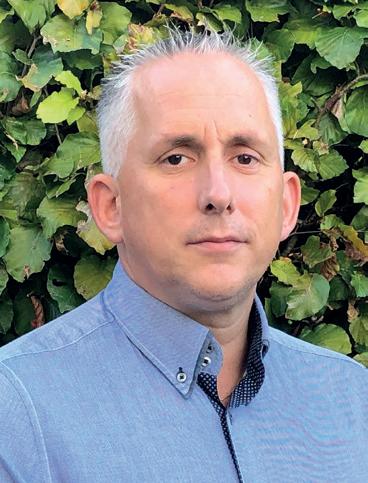
“Many buyers now use cost comparison software to make the buying decision. The lowest-priced supplier wins the business, but margins often collapse and can ultimately threaten the entire business.”
He continues: “Additionally, litigation against aftermarket companies for OEM patent infringement is rife. To cap it all, transactional sales are coming back into fashion as contractual MPS demand slows due to the rise of hybrid working – a trend that will not go away.”
SECURITY CONCERNS
Fraudulent activity is as big a topic in the print space as it is in many other verticals. According to Quocirca, 61% of organisations have reported a print-related data loss and 27% of cybersecurity incidents are related to paper. The average cost of these data breaches is in the region of £740,000 ($952,000). This is creating a range of opportunities for suppliers to deepen their cybersecurity expertise and deliver security-led print solutions.

Kevin Pineda, Merchandise Manager, Technology at S.P. Richards (SPR), notes: “Security is uppermost in customers’ minds when considering print devices. New software solutions are being deployed daily to help secure end-customer accounts. Equally important is that service expectations are growing, with businesses wanting support to monitor, update and manage firmware across their print fleets, ensuring they’re as free from vulnerabilities as possible.
“These added services allow OP resellers to provide the higher level of value their customers seek. As such, many now realise it offers a profitable additional opportunity, making contracted print more relevant.”
Weedon adds that printer security is also a concern. He explains that because Lexmark is Chinese-owned, some competitors are creating a fear factor that China could be
CATEGORY UPDATE Imaging Supplies/MPS/Print 46 www.opi.net
Steven Hole
Steve Weedon
For more expert comments about the MPS, imaging supplies and print space, including topics such as sustainability, digitisation and the need for added security measures, see our Xtra content in the September issue on opi.net
spying on companies and government agencies using Lexmark devices. He adds: “I don’t think this can or will be proven either way, but buying decisions are clearly affected by this possibility, causing Lexmark anxiety.”
Holmes warns the attention of bad actors –potential or real – on the print industry makes it vitally important print ecosystems continue to collaborate to develop robust solutions. He adds: “It’s essential to hammer home the message that security is about the product, but also about people and policy. One benefit of the cloud is that security is constantly updated seamlessly in the background, assuring customers always have the most recent and robust protection for their confidential data.”
However, according to Static Control, there’s a flipside to this, with some OEM suppliers pushing out firmware updates in the name of security, but which are actually locking out some aftermarket cartridges.
“This gives us added value compared to a conventional supplier and the same should be true for office supplies dealers. Excellent customer service and clear communication will help them rise to the top.”
The fact many operators were already diversified prior to the pandemic meant they were better placed to navigate the storm that dedicated print sellers suffered, according to SPR. “These broader relationships have also made progressive resellers the first port of call for contracted services,” adds Pineda.
“Dealers must be proactive in the MPS space to take advantage of the growth this offers. There’s been tremendous momentum building around contracted print over the past 18 months, and we expect this to continue for the foreseeable future.”

But, says Distribution Management’s Moore, while many dealers realise the need to get into contractual business, few actually take the necessary steps to do so. This means they are losing their ink and toner sales. “Copier dealers will be able to offer better price points, with full service back-up. Unless OP dealers have invested in this type of infrastructure, it’s going to be hard for them to compete within the print and imaging category,” he cautions.
Hole asserts: “We’re seeing firmware being delivered in totally new ways with consumers having no understanding or knowledge of. They’re then surprised to find that the cartridge they were printing with one day doesn’t work the next.
“In the past, when a firmware update was released, users had to actively update their printers. However, now you have firmware being delivered without notice, for example time-bomb firmware loaded at the factory and triggered to go off at some future date.
“Or a program in the cartridge chip that, when installed, updates the firmware on the printer. Sometimes people have signed up, intentionally or not, to receive automatic updates which are pushed to them via the web. Our message to our customers is: do not update your printer firmware under the guise of security issues.”
DIVERSIFICATION AND DIFFERENTIATION
Despite the challenges facing the sector, there are still significant opportunities for office supplies dealers operating in this category.
Static Control strongly believes the way to compete in this market is to differentiate yourself from the competition by providing more than just a product. “We put huge emphasis on local customer service in multiple languages, with technical support, training and other nuances,” says Hole.
AN UNCERTAIN FUTURE
Experts foresee further choppy waters ahead, with adverse market forces gathering strength and technological turbulence on the horizon. Reynolds anticipates that the pressures on OEMs, for instance, will likely see some merging or even disappearing from the print market entirely. “Those that remain are going to need to up their game, particularly with regard to their environmental credentials.”
Weedon predicts that more businesses will go bust as they try and compete on price by cutting corners, infringing patents and sacrificing on quality: “This is completely the wrong direction to take and the consequences will be severe. Customers do want choice and value-add, especially concerning eco-friendly alternatives – a pile it high and sell it cheap philosophy is a misguided approach.”
Quocirca forecasts that AI will become the next battleground for the print industry –specifically the advent of intelligent document processing. This uses a combination of automatic character recognition and natural language processing to capture, extract and process data from a variety of document formats – both paper and digital – without any human input. It’s set to transform the print and imaging industry.
Plenty of food for thought for a category that’s already under pressure.
CATEGORY UPDATE Imaging Supplies/MPS/Print September 2023 47
Dealers must be proactive in the MPS space to take advantage of the growth this offers
While ACCO Brands as a global consumer products business offers print finishing machines and tools under its Swingline, Rexel, Leitz and Xyron brands, it is the vendor’s GBC entity that is the most focused on the laminating segment.
General Binding Corporation, founded in 1947, set out to help printers in the Chicago area find a faster, more efficient and reliable way to bind and laminate important business documents. The acquisition of the SEAL brand in 2013 added wide format print finishing solutions, with lamination equipment and supplies to meet the needs of the growing sign and display graphics marketplace.
OPI speaks to ACCO Brands Senior Product Manager Brian Klein about GBC and its continuing relevance amid a wide and varied –and increasingly discerning – customer base.
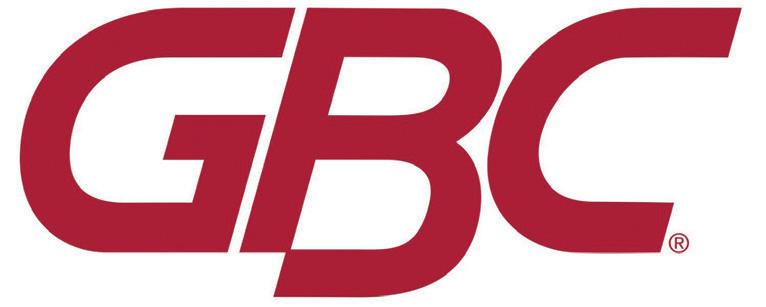
OPI: The laminating category is typically regarded as somewhat of a traditional sub-segment. Would you concur with that?
Brian Klein: While laminating machines and supplies might have roots in traditional practices, they have undoubtedly evolved into technology-enabled products. GBC has a rich history of advancing product segments through solution-driven innovation in areas such as automated functionality, improved throughput, workflow efficiency, ease of operation and lower total cost of ownership.
Despite today’s digital age, the need for physical document protection remains extremely relevant. Laminating machines continue to play a significant role in various
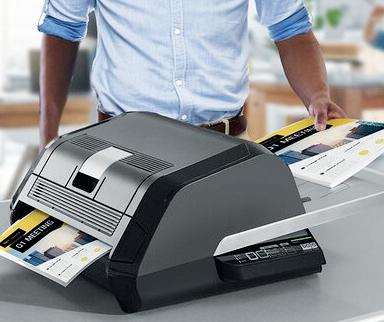
LAMINATION in progress
industries where they help preserve important documents and improve the durability and weather resistance of sign and display graphics. Our customers want to safeguard their printed documents and we continue to experience growth in most sub-segments of our finishing business.
OPI: How would you describe your customer portfolio in this category?
BK: The client base for laminating machines and consumables is quite extensive, covering educational institutions, businesses of all sizes, home offices and entire industries that require protection and enhancement of printed materials. The versatility of the products involved allows them to cater to a broad range of needs, making them essential tools in many work settings.
Laminating machines are very commonly used in schools, for instance, to preserve educational materials such as posters, flashcards and teaching aids as well as visual support and wayfinding signage. Laminated items are more durable and can withstand regular handling, making them ideal for classroom use.
In office environments, they protect important documents including presentation materials, signage, employee badges and reference materials. Small businesses may also use machines to design professional-looking marketing materials, product labels and other sales support documents.


Retailers create price tags, product information sheets and promotional materials, while professional print shops utilise
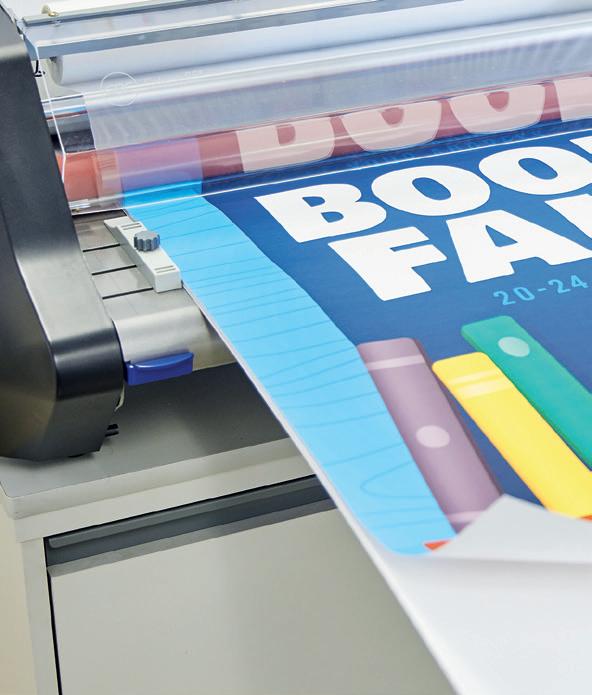
48 www.opi.net ADVERTORIAL
Document protection – physical as much as online – is timelessly important. And the technology that facilitates ever more sophisticated laminating results is constantly improving
laminating machines to offer customers a wide range of printed products with enhanced visual appeal. These range from sign and display graphic applications, menus, brochures and business cards.

In addition, lamination plays a role in the packaging industry to protect labels, tags and other materials from wear and tear. Some laminates enhance the texture and feel of the packaging, boosting shelf appeal and user experience.
OPI: GBC is a well-known brand in the laminating space. Which products and solutions would you highlight?
BK: GBC solutions are designed to meet the specific needs of large traditional offices, small home offices and the modern hybrid worker. Our Fusion series of pouch laminators vary in size and capability, safeguarding presentation, important documents and visual aids. The Foton 30 promotes efficiency and makes lamination easy as it feeds, laminates and trims automatically.
The GBC Ultima 65 27” laminator is a favourite among educators to protect and preserve classroom materials. Finally, our wide format laminators meet the demands of production print and sign shops for media up to 64”.
Our Full Service Circle organisation staffs factory-trained technicians who ensure machines remain operational and efficient. Our recently launched Service Solved programme extends professional technical service to customers’ equipment besides our own. Clients also have access to training programmes and educational resources to maximise the benefits of their laminating equipment.
OPI: How have changing work patterns –work-from-home, for example – or industry trends accelerated or perhaps even altered innovation in this category?

BK: The changing office landscape, including the adoption of hybrid work models, accelerated the need for user-friendly and efficient laminating processes. Automated laminators have been developed, expanding the ease of use through incorporating automated settings that adjust lamination parameters based on material type, thickness and desired finish.
There are several other trends. One of them is sustainability, with calls for eco-friendly materials and processes to meet the demands of environmentally conscious customers. And, with increased compliance to the Americans with Disabilities Act – ADA in short – there has also been further use of embossed and textured films.
There will likely be further development for speciality applications and unique finishing solutions centred around embellishment, texture and durability.
OPI: What service component is required –what are customers asking for?
BK: GBC has a full-service approach that fosters long-term relationships with customers. We have a strong brand reputation built on commitments to quality and customer service. And we are known as trusted partners in the laminating industry.
OPI: Finally, for a bit of future gazing –where is the category headed?
BK: Like many other industries, the lamination sub-segment will likely witness further technological advances. Laminators may become more intelligent and automated, offering seamless integration with digital workflows and cloud services.
Smart and connected laminating machines could allow users to operate and monitor devices remotely and enable predictive maintenance, automatic reordering of supplies and real-time job status updates, for instance.

Any of the above would result in enhanced efficiency and a better user experience. Additionally, eco-friendly compostable and speciality films and finishes will continue to advance to meet customers’ growing sustainability initiatives.
It’s a future I’m very excited about and wherever it takes us, GBC will certainly continue to lead innovation based on the evolving needs of our customers. For more details, visit https://www.gbc.com/
ADVERTORIAL ACCO Brands September 2023 49
GBC
will certainly continue to lead innovation based on the evolving needs of our customers
All registered and unregistered trademarks are the property of their respective owners. © 2023 ACCO Brands. All Rights Reserved.
Seeking the BEST
NORTH AMERICAN OFFICE PRODUCTS AWARDS PREVIEW
For the third consecutive year, the North American Office Products Awards (NAOPA) are being hosted by OPI in association with Independent Suppliers Group (ISG). A total of nine awards will be presented at Industry Week ’23 powered by ISG in New Orleans, Louisiana, from 8-11 October.

The judges were once again delighted by the high calibre of product entries across each of the categories. They noted the impressive display of innovation, creativity and environmental thinking which are key criteria at the NAOPA
The shortlist for all Best Product and Innovation of the Year categories is as follows:
BEST PRODUCT – CORE BUSINESS
PRODUCT
3M – Scotch Box Lock Paper Packaging Tape
3M – Scotch Unboxing Scissors
ACCO Brands – Quartet Vertical InvisaMount
Magnetic Glass Dry-Erase Board
Deflecto – OceanMat Chair Mat
Kensington – MK7500F QuietType
Pro Silent Mechanical Keyboard
Lavazza North America – FLAVIA Creation
300 + Chill Refresh Brewer
BEST PRODUCT – FACILITIES, BREAKROOM, SAFETY & INFECTION CONTROL
Avery – Durable ID Cards & Badges
Eco-Products – Vegware – Renewable and Compostable Food Service Disposables
Fellowes Brands – Fellowes Array
Networked Air Purifiers & Monitoring
ITW Pro Brands – SCRUBS NO RINSE
Food Surface Disinfectant Wipes
For more details about the North American Office Products Awards, please visit opi.net/ naopa2023
OttLite Technologies – Wellness Series
SanitizingPro LED Desk Lamp and UV
Air Purifier
Reckitt – Lysol Pro Solutions Disinfecting
Wipes 800 ct. Bucket and Refill Packs
BEST PRODUCT – FURNITURE & DESIGN
ACCO Brands – Quartet Vertical InvisaMount
Magnetic Glass Dry-Erase Board
Durable – Mobile TV Cart COWORKSATION
Ghent – Control Shelving Unit
Kantek – Mobile Height Adjustable
Sit Stand Desk
Nook Pod USA – Nook Air
The HON Company – Flexion
BEST PRODUCT – TECHNOLOGY
Fellowes Brands – Fellowes Array
Networked Air Purifiers & Monitoring
Ghent – Aria Connect
Kensington – H3000 Bluetooth
Over-Ear Headset
Kensington – MK7500F QuietType
Pro Silent Mechanical Keyboard
OneScreen – Touchscreen TL7
Prima Edge – PrimaGo
INNOVATION OF THE YEAR
3M – Scotch Box Lock Paper Packaging Tape
3M – Scotch Unboxing Scissors
Dealer Delivery Network – The Dealer Delivery Network Hub
Fellowes Brands – Fellowes Array Networked Air Purifiers & Monitoring
OneScreen – Touchscreen TL7
Cubii – Cubii Total Body+
REWARDING INDIVIDUALS
For the second time, there is also a shortlist for Young Executive of the Year to highlight budding leaders of the future.
YOUNG EXECUTIVE OF THE YEAR
Daniel Benjamin – President, Benjamin Office Supply
Tyler Condry – President, Sundance Office
Kelly Ennis – Chief Revenue Officer, JAM BNC
Alicia Kolbus – Analytics Specialist, Stinson’s Andy Richter – President, Richter Total Office
Two further awards will be presented during Industry Week: Professional of the Year and Industry Achievement – there is no shortlist. Finally, there will be the highly anticipated and hugely popular People’s Choice award, selected from any of the shortlisted products in the categories listed above. Further details on the items and how to vote can be found on the following pages.
50 www.opi.net EVENT
Now a staple in the US business supplies industry calendar, the North American Office Products Awards are back for 2023

Cast your vote
Here is your chance to select the top product(s) in the People’s Choice category of this year’s North American Office Products Awards (NAOPA)
You have three votes to submit and help select the winner of this year’s People’s Choice award from the 23 shortlisted products outlined here. Online voting is now available and is quick and easy to do – simply visit www.opi.net/peopleschoice2023
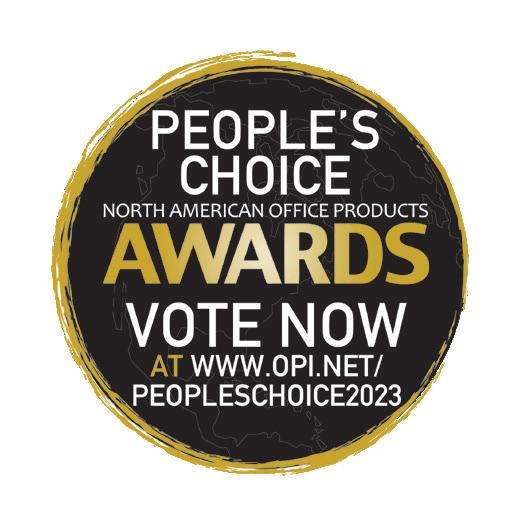
The winner will be announced at Industry Week ’23 powered by ISG, held in New Orleans, Louisiana, from 8-11 October.
3M – SCOTCH BOX LOCK PAPER PACKAGING TAPE
The Scotch Box Lock Paper Packaging Tape aims to achieve better box adhesion with its extreme grip. The tape is made with 45% bio-based content and recycles with ease alongside the box, meaning there is no need to remove it once the box is opened.


3M – SCOTCH UNBOXING SCISSORS
The Scotch Unboxing Scissors are a versatile cutting tool which can be used as an 8-inch scissor or, alternatively, a boxcutter – customers simply have to slide the pivot point with one hand. They utilise high-quality, precision-sharpened blades and have a non-stick silicone coating that resists adhesive build-up.
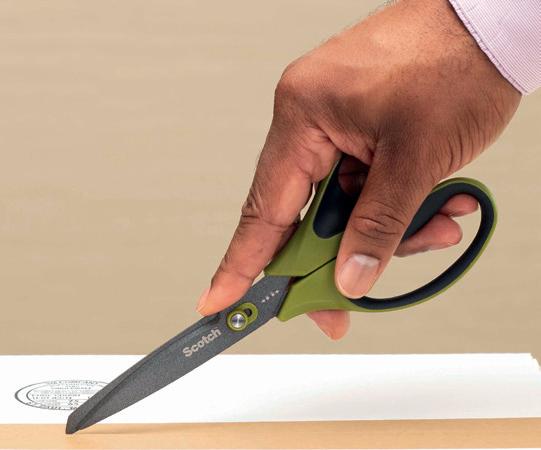
ACCO BRANDS – QUARTET VERTICAL INVISAMOUNT MAGNETIC GLASS DRY-ERASE BOARD
The Quartet Vertical InvisaMount Magnetic Glass Dry-Erase Board provides collaborative solutions for various work environments.
As facilities adjust to hybrid working models, open floor concepts grow – exactly what the Vertical InvisaMount line was created for. It is available in three sizes to allow for collaboration in all spaces, balancing the needs of teams and individuals. The invisible mounting hardware and frameless design gives the glass board a modern look.

52 www.opi.net EVENT NAOPA 2023
AVERY – DURABLE ID CARDS & BADGES

Avery Durable ID Cards & Badges let users quickly and easily design and then print customised ID cards and badges from a laser printer. They are made out of tough polyester material that is waterproof, tearproof and resistant to chemicals, abrasion and UV fading.

DEALER DELIVERY NETWORK –THE DEALER DELIVERY NETWORK HUB
The Dealer Delivery Network Hub was developed for and by the independent dealer community and intends to revolutionise its ability to compete on national accounts. It provides customers next-day, white-glove delivery anywhere in the US using an entirely automated process. The software includes order transfer, acknowledgements, PODs and accounting.

DEFLECTO – OCEANMAT CHAIR MAT

The Chair Mat is a sustainable solution to prevent damage to carpets and extend floor life. It is made using 100% recycled, ocean-bound plastic that would otherwise end up in landfill or polluting the ocean. The range is available for carpeted and hard floors in businesses or home offices.
CUBII – CUBII TOTAL BODY+
The CUBII Total Body+ combines the low-impact cardio of an elliptical with the ergonomic pulley system of a rowing machine. The compact, portable design enables a full-body workout experience from wherever you sit. It builds lower-body strength, increases upper-body muscle and improves mobility.
It is designed to easily fit into compact spaces and connects to the Cubii mobile app via Bluetooth which also lets users customise their workout to match ability.

EVENT NAOPA 2023 September 2023 53
DURABLE – MOBILE TV CART COWORKSATION
The COWORKSATION is designed for video conferencing and presentations in modern workspaces. Given the growing amount of video calls in hybrid work environments, TV trolleys are becoming a key piece of equipment to adapt workspaces to meet changing demands.

It features a handle and a cable holder as well as storage compartments for accessories.
GHENT – ARIA CONNECT
ECO-PRODUCTS – VEGWARE – RENEWABLE AND COMPOSTABLE FOOD SERVICE DISPOSABLES
Vegware by Eco-Products is manufactured using a variety of renewable, plant-based materials. They are designed to be commercially composted with food waste where accepted. Independent bodies have certified the products break down in fewer than 12 weeks in industrial composting facilities.


Aria Connect provides a presentation experience for meeting participants whether they are attending in person or virtually. It includes a Kaptivo image-capturing camera and an Aria Glassboard with integrated calibration graphics for a complete collaboration system.

Cloud-based connection also ensures images are broadcast securely and glare-free for a clear picture to any remote workers.
GHENT – CONTROL SHELVING UNIT
Ghent’s Control Shelving combines the functionality of a wall, shelving and noise-reducing acoustic PET panels to create a controlled and productive workspace in homes and offices.
Multiple units are fully configurable in a variety of arrangements and available in a selection of laminate and veneer stains to match different aesthetics.
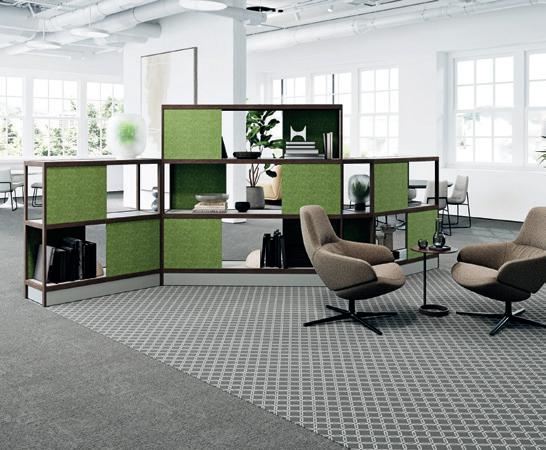
54 www.opi.net EVENT NAOPA 2023
FELLOWES BRANDS
–FELLOWES ARRAY NETWORKED AIR PURIFIERS & MONITORING
Fellowes Array comprises an integrated range of air purifiers, sensors and monitoring software that can be connected to form a complete network for healthy air in any space. The advanced system provides a complete picture of a facility’s air quality, then compiles the data into a dashboard.


ITW PRO BRANDS – SCRUBS NO RINSE FOOD SURFACE DISINFECTANT WIPES

SCRUBS NO RINSE Food Surface Disinfectant Wipes simplify training and cleaning processes by disinfecting without needing any after-rinse.
The pre-moistened wipes leave facilities clean and sanitised in one time-saving step, while eliminating the guesswork of measuring cleaning chemicals.
KANTEK – MOBILE HEIGHT ADJUSTABLE SIT STAND DESK

Kantek’s Sit Stand Desk is produced for the home, office and school. It features a pneumatic lift mechanism that adjusts the platform from 29”-44” (0.7 m-1.1 m).
It also includes an extra-large work surface with indentations for a phone or tablet as well as a cup holder.
KENSINGTON – H3000 BLUETOOTH OVER-EAR HEADSET
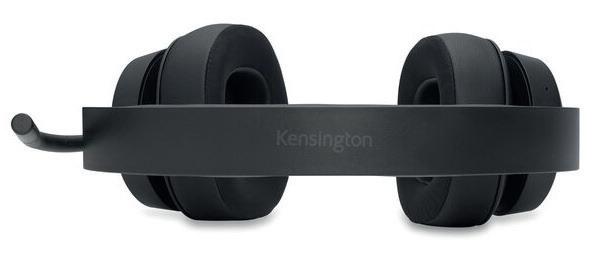
Another product designed for the evolving workspace is the H3000 Bluetooth Over-Ear Headset from Kensington. The wireless headset means users can move freely while the cooling gel-infused earpads with heat-transferring fabric allow for all-day comfort.
The headset also features AI-powered noise-cancelling technology to suppress background sound.
EVENT NAOPA 2023 September 2023 55
KENSINGTON – MK7500F QUIETTYPE PRO SILENT MECHANICAL KEYBOARD
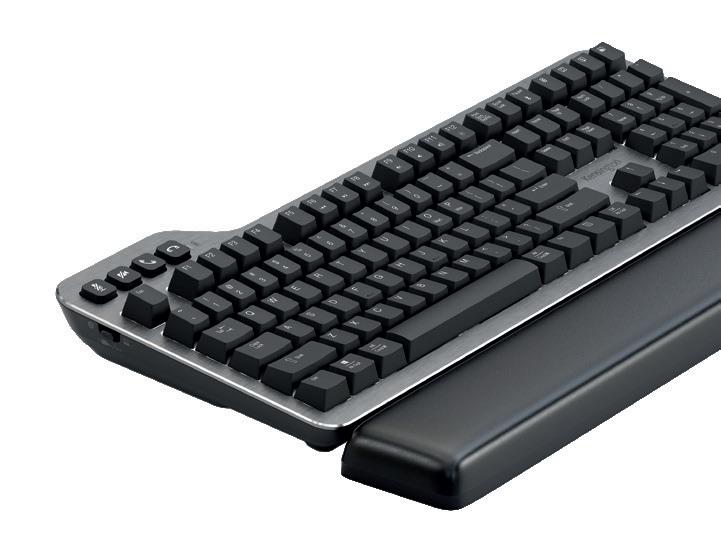
Built for comfort and productivity, the MK7500F keyboard is quieter and more tactile than mainstream membrane equivalents. The ergonomic design makes the keyboard comfortable for all-day use while its integrated meeting control keys enhance productivity by simplifying camera and audio controls.
It also features a full-size ergonomic extruded aluminium frame and an adjustable white backlight.
LAVAZZA NORTH AMERICA – FLAVIA CREATION 300 + CHILL REFRESH BREWER
The FLAVIA Creation 300 + Chill Refresh Brewer is a mid-sized workplace machine that delivers a variety of drinks. It offers 14 types of beverages including infused waters, served hot or cold, as well as tea and coffee.
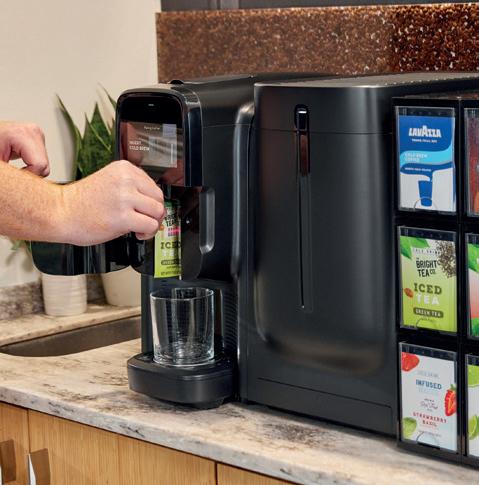
The compact size and price point have made it an instant success at Lavazza – within two months of going on sale, it made up 37% of its brewer system portfolio.
NOOK POD USA – NOOK AIR

Nook Air is a multi-purpose, mobile pod designed to elevate productivity and collaboration. It seats up to four people, and the acoustic panels and insulated walls help carry voices without needing to shout.
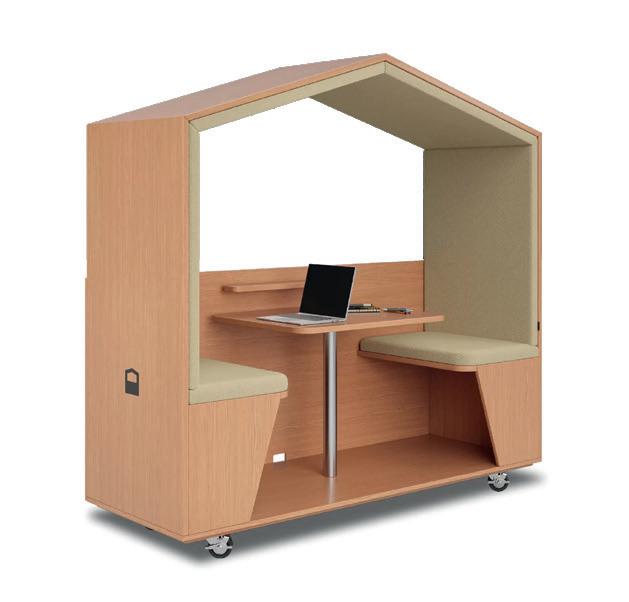
The Nook Air is made using post-consumer recycled materials and comes pre-configured with Nook’s wellness and focus-centric features.
ONESCREEN — TOUCHSCREEN TL7
The Touchscreen TL7 is a teacher-centred interactive whiteboard that combines fast processors, large memory and an intuitive interface with zero-bonded touch. The split-screen technology allows teachers to open an Android app on part of the screen while running Windows software alongside it.
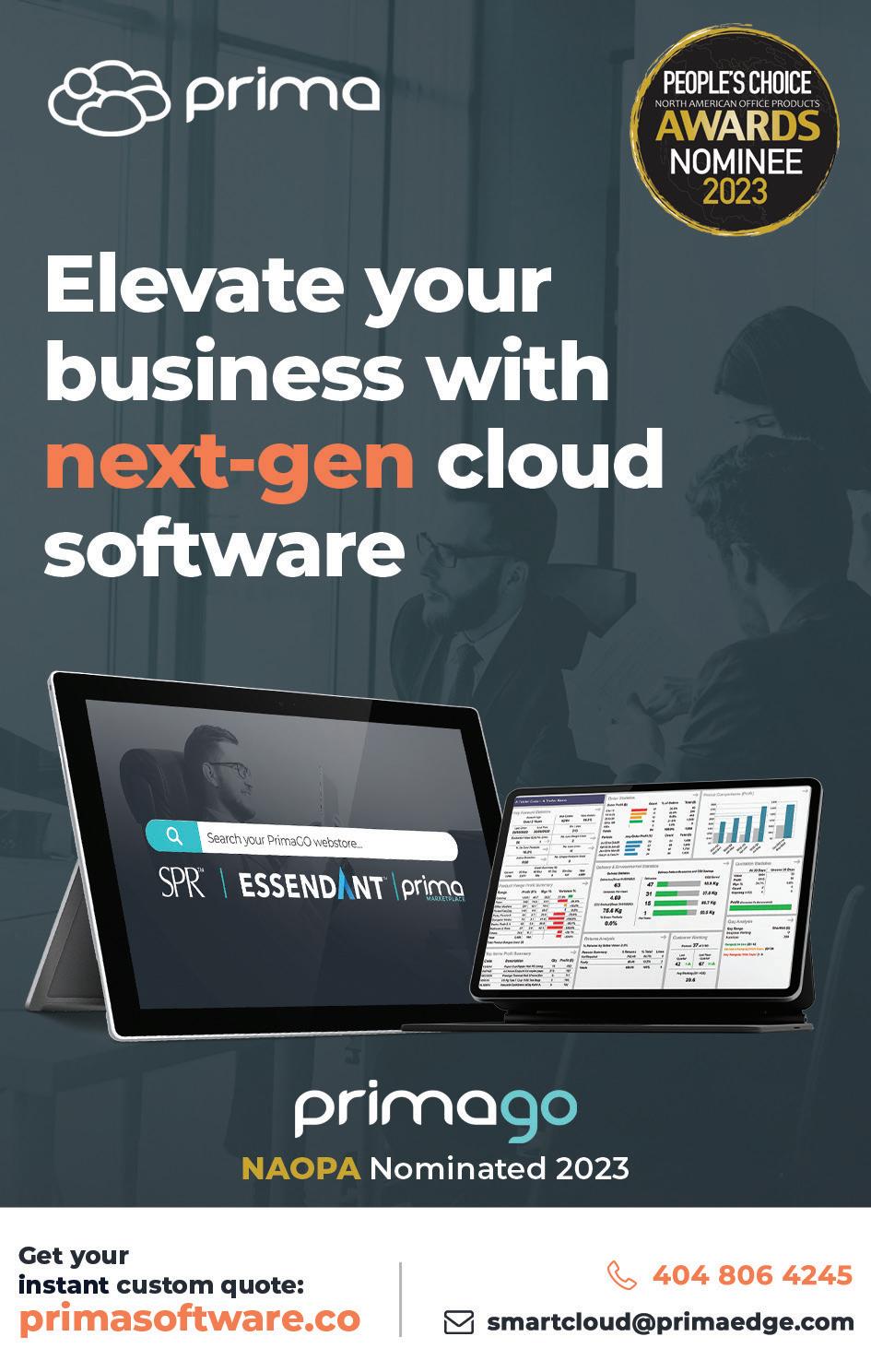
Also, hand-written notes convert into printed fonts and sketched shapes turn into precise diagrams.

56 www.opi.net EVENT NAOPA 2023
OTTLITE TECHNOLOGIES – WELLNESS SERIES SANITIZINGPRO LED DESK LAMP AND UV AIR PURIFIER
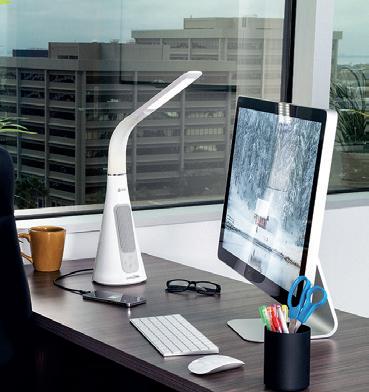
This product by OttLite Technologies has a patent-pending design that uses three sanitising techniques to create a healthier space. They include patented SpectraClean LED technology to reduce bacteria; UVC LEDs to reduce bacteria and viruses; and a HEPA filter to capture airborne particles.
The lamp also features OttLite ClearSun LEDs which are specially developed to reduce glare and eyestrain.
PRIMA EDGE – PRIMAGO
PrimaGo is a fully integrated shopping experience designed exclusively for business product resellers. The standout features include its integration with Prima Cloud ERP and Prima Marketplace, enabling resellers to manage all their business operations from a unified platform.

RECKITT –LYSOL PRO SOLUTIONS DISINFECTING WIPES 800 CT. BUCKET AND REFILL PACKS
The 800 ct. format of Lysol Pro Solutions’ Disinfecting Wipes offers businesses a more cost-effective wipe – compared to the Lysol Disinfecting Wipes 80 CT. canister. It yields operational efficiencies including reducing restock and refill occasions.
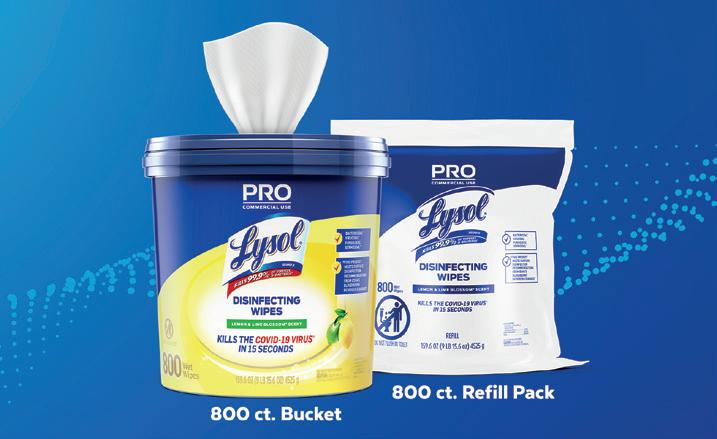
In addition, the bucket and lid which enclose the wipes are made from 50% post-consumer recycled material and support reuse and refills up to 25 times.
THE HON COMPANY – FLEXION
Flexion is a versatile seat, ideal for unassigned seating spaces such as benching, touchdown and hybrid areas. Given the rising number of people working from home, the seat was designed to be as flexible as workspaces have become in the past few years.

It has a dynamic flex suspension and uses a four-point seat support to absorb body movements.
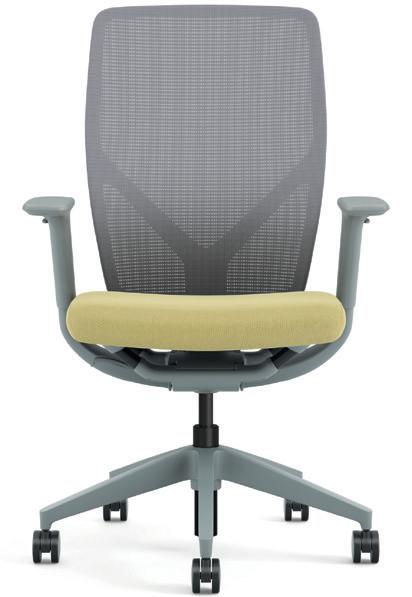
EVENT NAOPA 2023 September 2023 57
Getting together IN THE BIG EASY W
ith two successful outings under their belts in Florida and Las Vegas, Independent Suppliers Group (ISG) will host this year’s Industry Week ’23, powered by ISG, at the Hilton New Orleans Riverside from 8-11 October.



The event is slightly shorter this year, with a hiatus for the one-on-one meetings for Pinnacle Group members meaning the total run time is three days. There is still a dedicated get-together and a peer exchange session planned for Pinnacle members on the opening day of Industry Week, however.
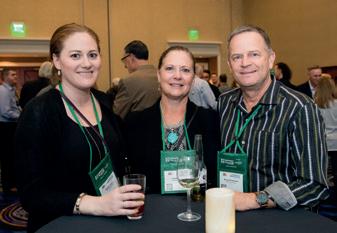
DAY OF EDUCATION
The first full day sees the start of the wider educational programme, with a Direct Buy panel discussion for ISG members, which will focus on the buying group’s current mantra of ‘Buying Direct and Selling Brands’. This will be followed by a host of seminars.
After lunch, the General Session will open with a few words of welcome from outgoing ISG President/CEO Mike Gentile as well as from Industry Week’s premier sponsor, The HON Company.
OPI CEO Steve Hilleard will then conduct interviews with key players in the US independent dealer channel (IDC) under the umbrella title Discovering the Power of Diversification. They will examine current and future opportunities for the IDC in terms of generating profit in new product categories.
The session will conclude with an address from ISG board Chairman Yancey Jones Jr, a City of Hope presentation and the 2023
North American Office Products Awards hosted by OPI Director Janet Bell. A New Orleans jazz-themed welcome reception in the evening should provide some relaxation time and plenty of networking opportunities for all attendees.
Day two begins with wholesaler Essendant hosting its own General Session followed by the BSA Forum, comprising a members-only round table and a think tank session for all manufacturers on the shifting economy.
PRODUCT SHOWTIME
After the conclusion of the seminar programme, it’s all change and the action moves from the hotel to the neighbouring Ernest N. Morial Convention Center for lunch and the tradeshow.
Once again, dealers will be able to benefit from a number of money-saving show specials. One lucky dealer will also have the chance to win $2,500 by taking part in the Cajun Cash promotion whereby raffle tickets are awarded by trade show exhibitors for meaningful conversations they had at their booths.
Those raffle tickets go into a draw, with the winner revealed at Industry Week’s closing event which will take place at The Fillmore New Orleans, the younger sister to the original – and legendary – venue in Los Angeles. The nightclub has been host to some of music’s hottest artists such as Kacey Musgraves as well as long-time favourites Willie Nelson, Duran Duran and the Foo Fighters.
Industry Week wraps up on 11 October –perhaps by then, we will know where the 2024 event will take us!
Industry Week ’23 powered by ISG takes place from 8-11 October at the Hilton New Orleans, Louisiana. To register, visit https:// industryweek23. cventevents.com

58 www.opi.net EVENT
INDUSTRY WEEK ’23 POWERED BY ISG PREVIEW

MINUTES WITH...
Gert Gerber
What’s your life philosophy? What goes around comes around.
What scares you?
People with narcissistic traits.
What makes you happy? Happy people.

What do you do in your spare time? Spend time with my wife and my golf bag (and friend, left).

If you could trade places with someone for a day, who would it be and why? My mother. She died of cancer when I was 14. I would love her to be a part of my family, even if only for a day.

Best dinner party meal? Italian food of any kind.
Where would you most like to travel and why?
Africa – for the nature and the simple life.
Your favourite musician?
Freddie Mercury.
CAREER Q&A
Describe your current job. My focus as CEO of Office Supplies Denmark (OSD) is to optimise the back office functions for our dealer members to improve their margins. We work hard to get them good prices while at the same time cutting their administrative costs.

Your worst ever job?
I’ve never had a job I didn’t like, but there definitely have been companies with cultural and ethical issues I couldn’t get on board with.
Favourite time of the year? All the seasons have beauty, but spring and summer are my favourites.

What’s your guilty pleasure? Chocolate. That’s why I never buy any myself.
What is humankind’s greatest invention? Insulin. It saved my boy who was diagnosed with Type 1 Diabetes when he turned 11.
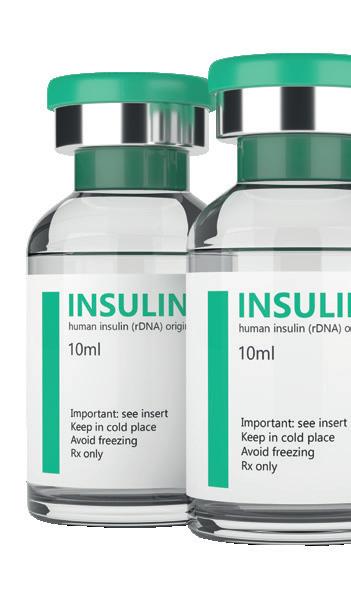
What is on your bucket list?
Live in another country for a while.
What skill would you like to master? Playing the piano.
Best way to spend the weekend? In our summerhouse (below) with my wife or visiting our children.
If you weren’t in your present job, what do you think you would be doing instead?
Work in another country and test my skills in a different culture.
Best moment in your career? When OSD succeeded in helping a company through the financial crisis in 2008/9 which saved a lot of jobs. Also coming back to my old job at OSD in 2015.



Best piece of advice to someone who has just joined our industry? Don’t look at the possibilities right now, but at the requirements for success in 5-10 years. You’ll be there before you know it.
If you could change one thing about our sector, what would it be? There should be more focus on a common logistics set-up, especially with the new restrictions about taking back packaging in mind.
60 www.opi.net 5
Gert Gerber, Office Supplies Denmark
The Gerber family

TIME-POOR, TECHNOLOGY-RICH
Our industry isn’t back to where it was pre-COVID – but it’s coming back. What didn’t come back are the employees. A lot of them either found higher-paying jobs or, in the case of older staff, they simply retired. It means dealerships didn’t just lose bodies, they lost valuable experience. Replacing all those people would cost considerably more in today’s labour market.
This leaves plenty of dealers in a catch-22: they are operating with fewer staff while struggling with distribution glitches and other challenges. The pandemic pushed more business online and, even now, many people are still working from home. Dealers have had to respond to all of this.
The technology is there, but a lot of them are so busy just trying to fill orders and service their accounts that they don’t have time to think and learn about it. So we, as a solutions provider, are doing some of this thinking for them.
BETTER ONLINE EXPERIENCE
We’ve been working on a new version of our webstore, for example. The first phase of the project – a revised home page and improved shopping cart with a faster checkout process – is already in beta testing. We are currently dealing with the catalogue and the way products are presented to the end user. It’s all about giving independents more parity with Amazon and the big boxes when it comes to their online presence.
SEO is a big issue. Are most dealers taking advantage of it right now? No. Again, they don’t have the time to think about SEO, digital marketing or social media. Nor do they have the employees to execute any of it. But when the remaining kinks are worked out of the supply chain and the labour crunch eases, the tools they require will be in place.
One of the biggest changes we’ve seen over the past year is the prevalence of punchouts. Dealers need this direct connection to their customers but it’s an additional cost. They should be cautious, making sure they will be getting enough business back for it to be worthwhile.
Dealers also need fast access to data – to monitor their clients and ensure nothing falls through the cracks, causing them to lose an
account. But they want it in a form that’s easy to comprehend as, yet again, they don’t have the time to really analyse it.
We are addressing this with major upgrades to our software’s built-in sales intelligence module. Some of those upgrades, like a new dashboard, have already been released and more are coming. We’re providing real-time information about things like overall sales, how customers are doing, what products are selling, and making it easy to quickly identify accounts which may be at risk.
John Evans, co-owner & President, SSI

PRICING PARITY


Dealers are rarely in the game because they offer the best prices. However, it doesn’t mean pricing isn’t hugely important. Dynamic pricing certainly is a must-do now. In the past, dealers would use matrix pricing from the wholesalers, but Amazon and the big boxes are repricing so frequently they are always behind the curve.
We have been pushing our customers to use Item411 for years. There’s no learning curve and it doesn’t consume precious time they don’t have. More dealers are starting to recognise the benefits and use pricing intelligence to push up their margins.
With pricing and margins in mind, a final issue: product and range. Some dealers carry just the main wholesalers’ products. Others load Essendant, S.P. Richards, plus Educator’s Resource and many others. They think they need to compete with Amazon.
The simple fact is, dealers need to be selling the items with the highest margin. Ordering direct with the minimum order quantities this requires and then holding inventory or, alternatively, getting product through a wholesaler at a premium – it all adds costs. We have done a lot of enhancements in our system which help guide consumers to the items dealers really want to sell because they make them money.
Dealers are in control of their own destiny. But they need help. In the form of technology.
62 www.opi.net FINAL WORD
FINAL WORD
The simple fact is, dealers need to be selling the items with the highest margin
TECHNOLOGY SOLUTIONS Special Special Issue
VENDOR SPECIA Special VENDOR SPECIAL Special Issue VENDOR SPECIA Special TECHNOLOGY SOLUTIONS














































































 Steve Holmes
Steve Holmes































































